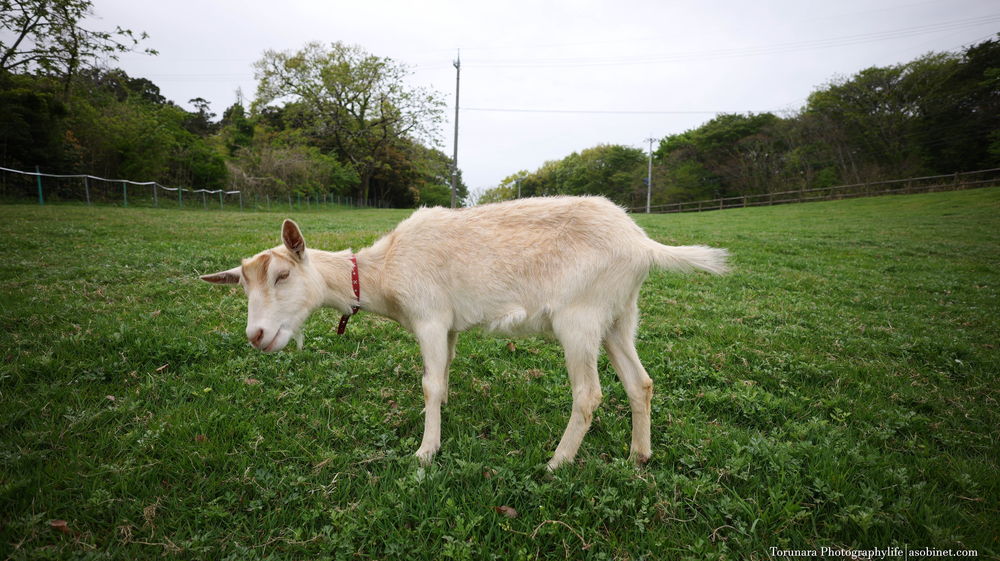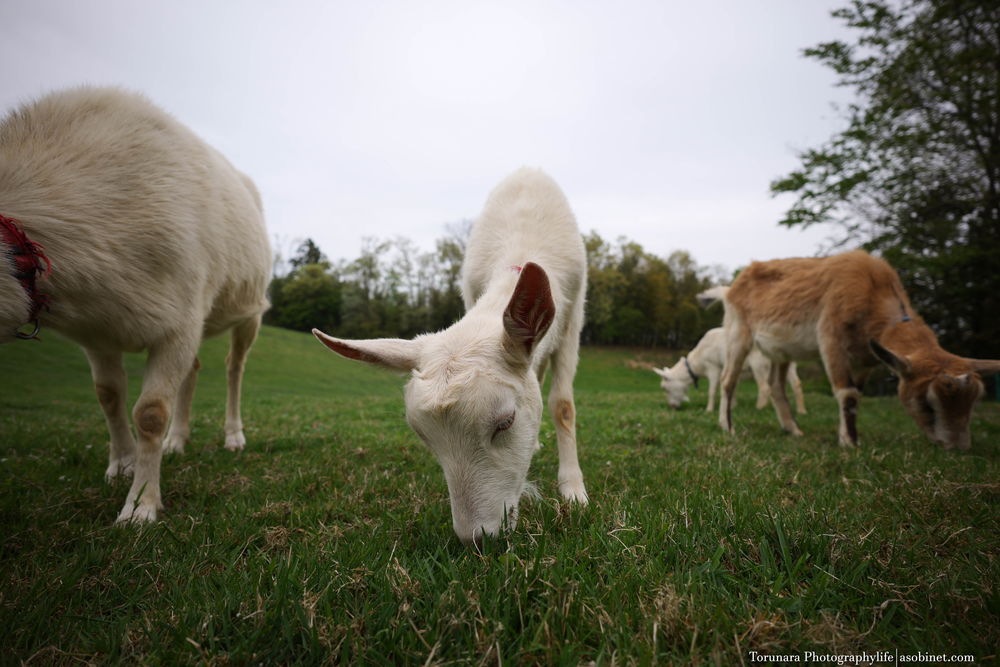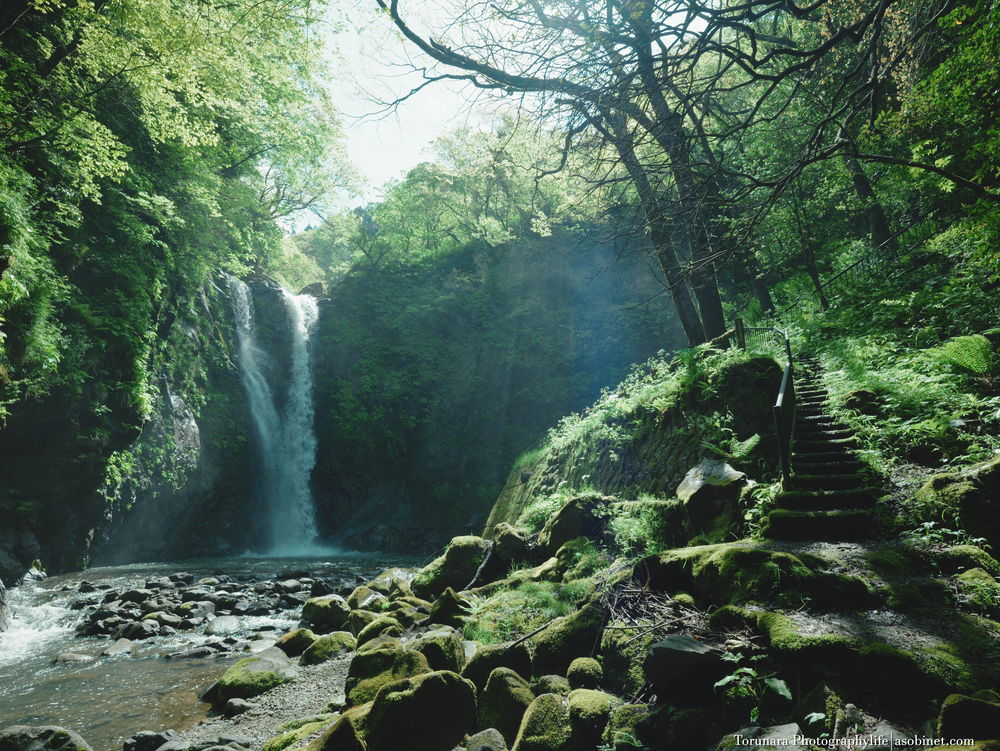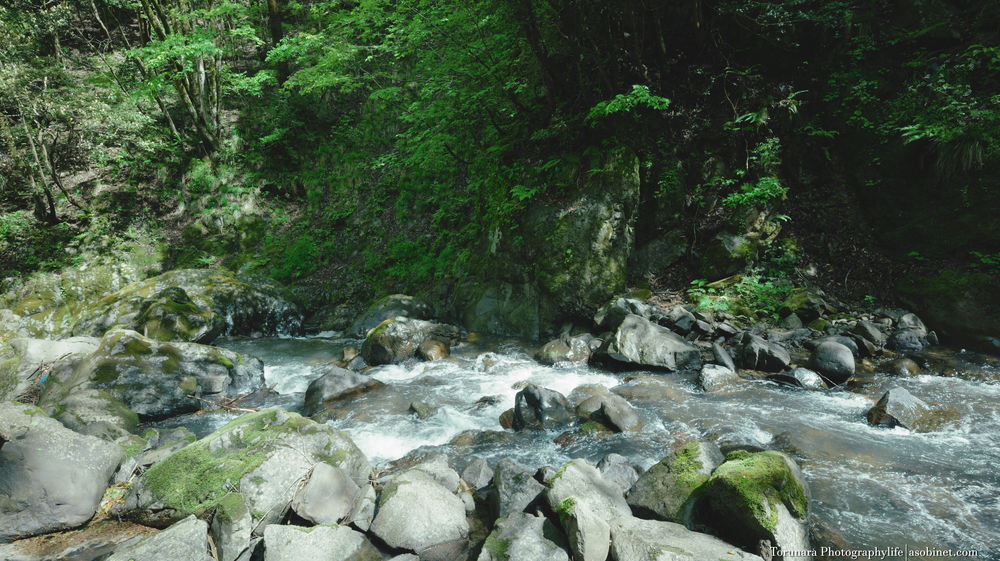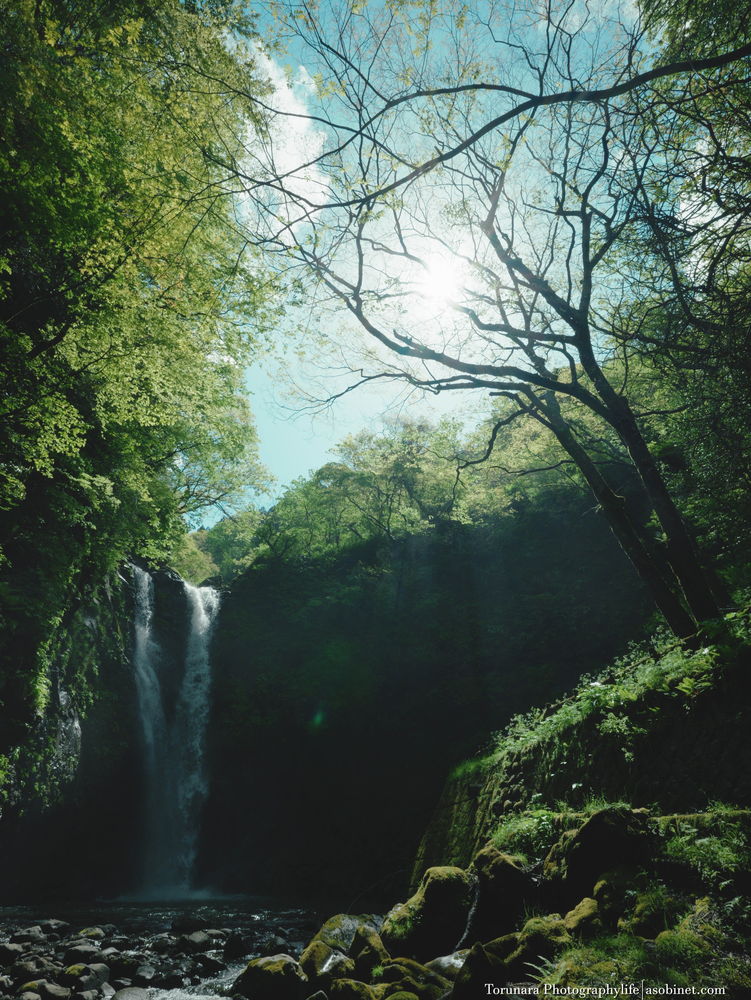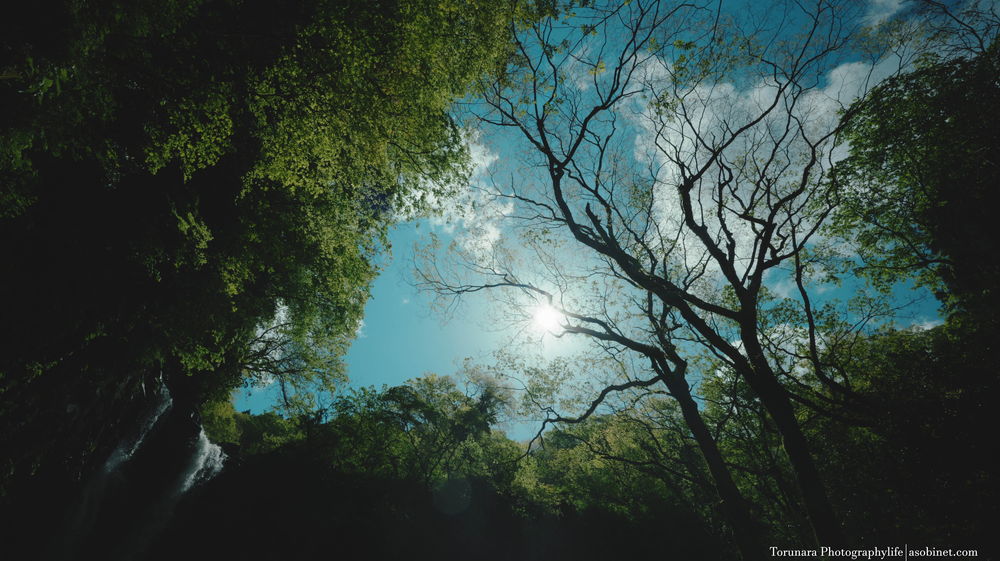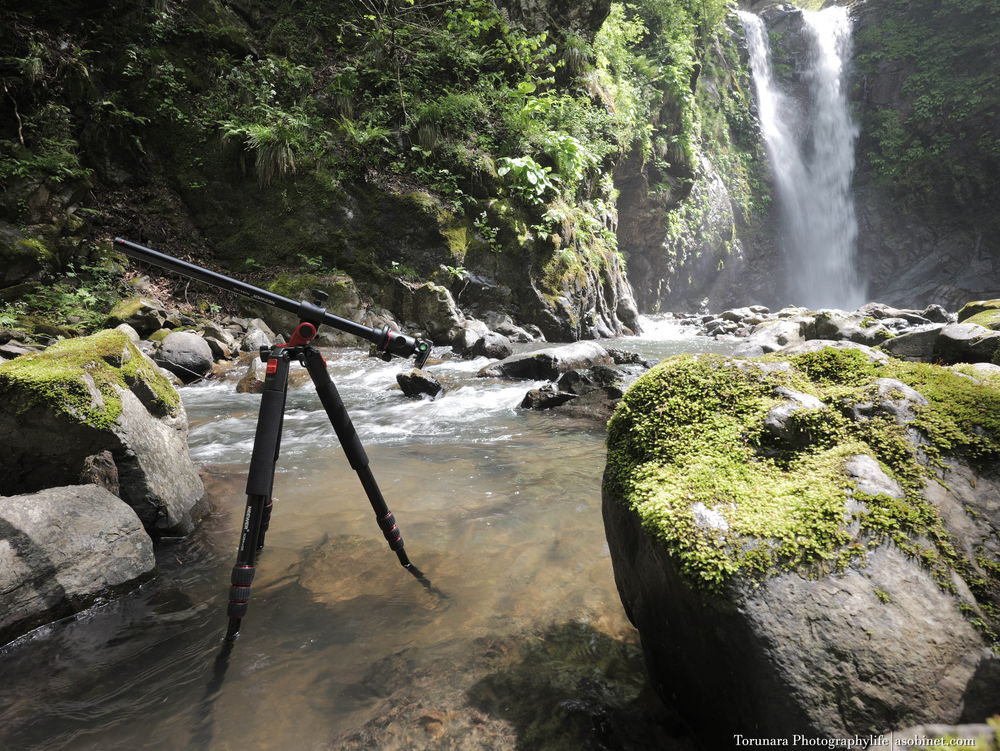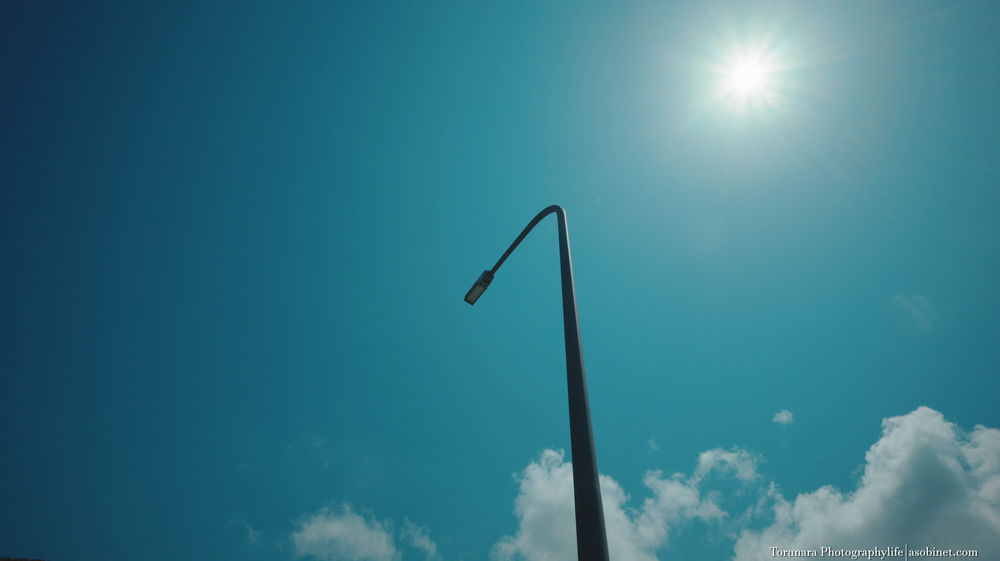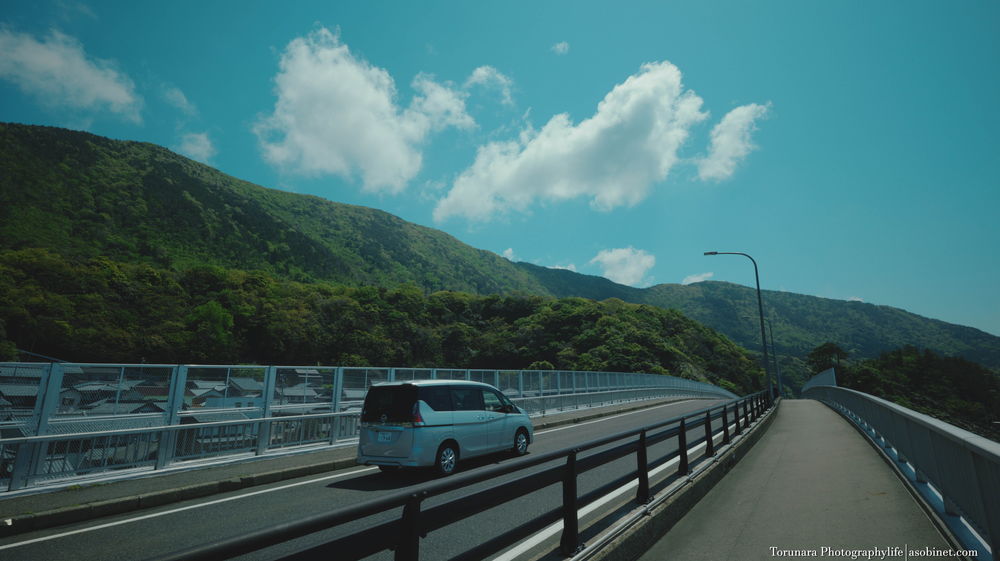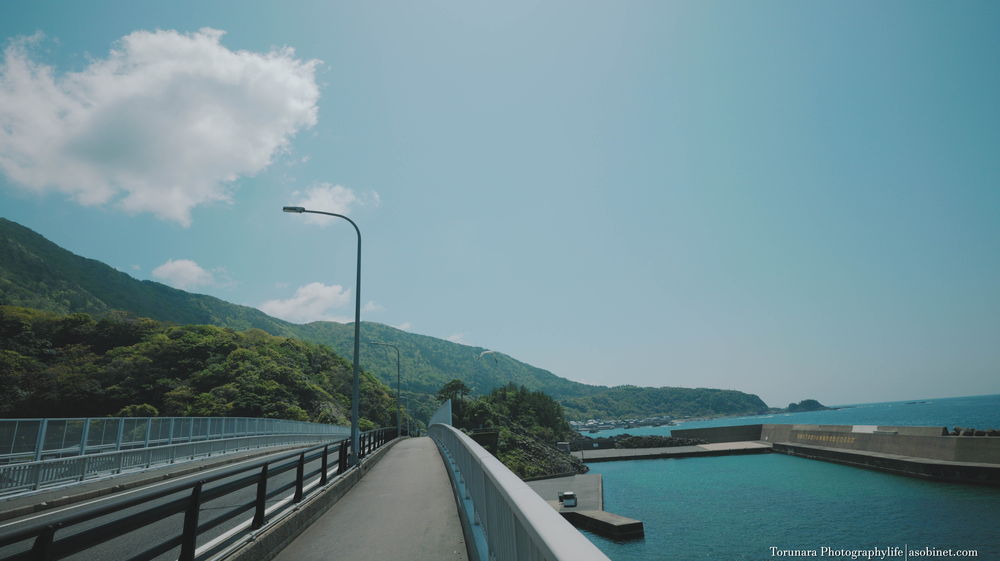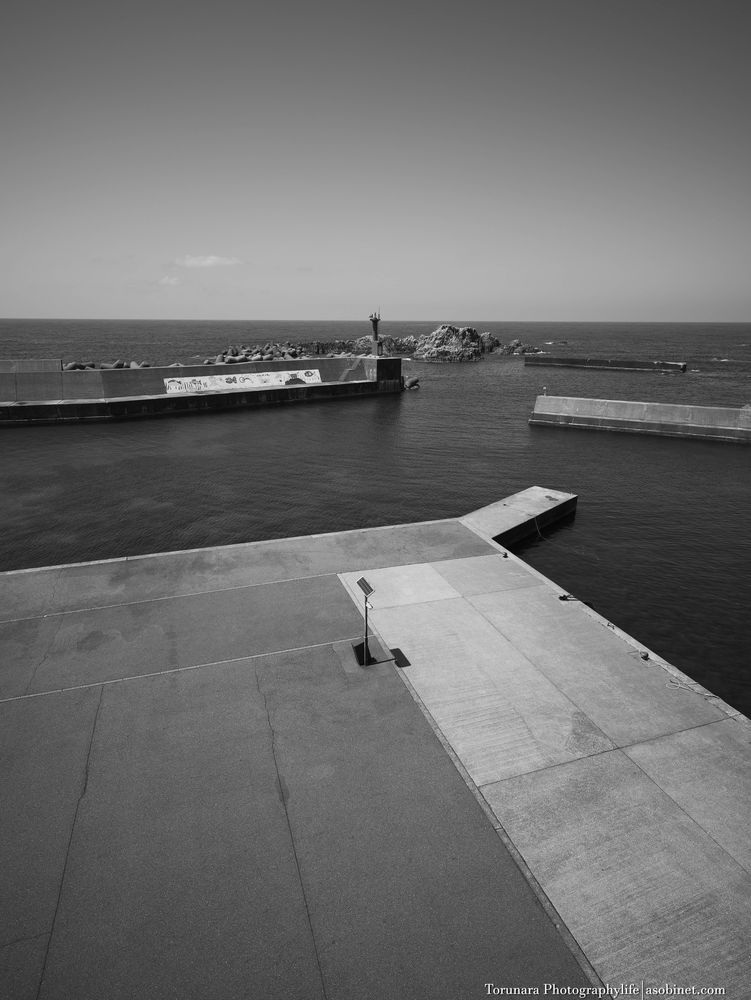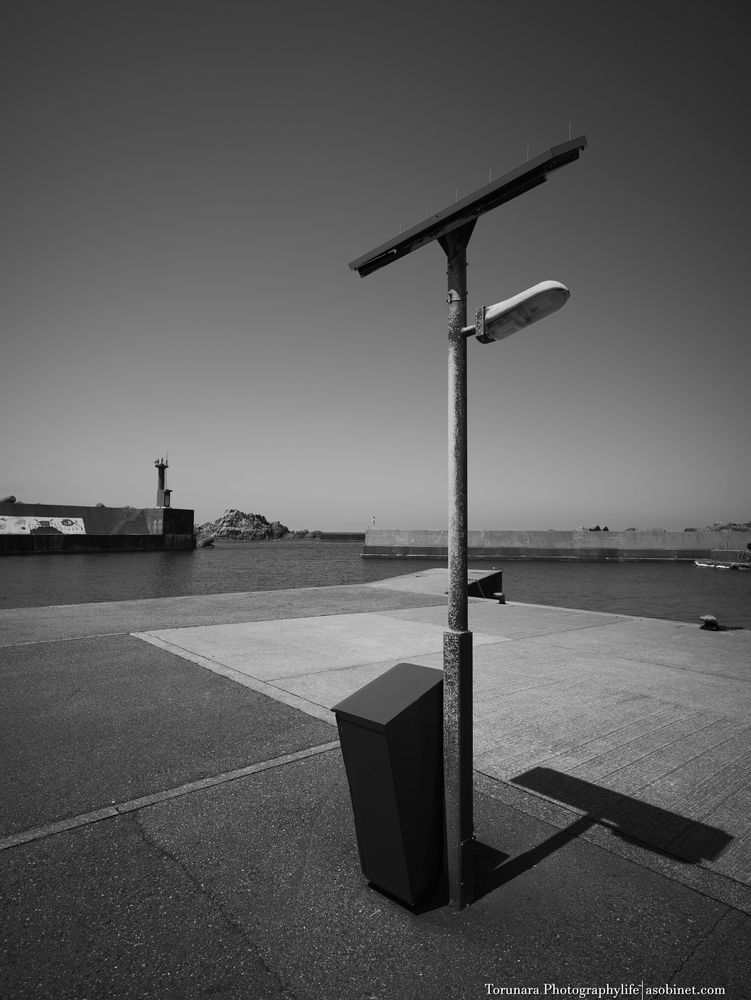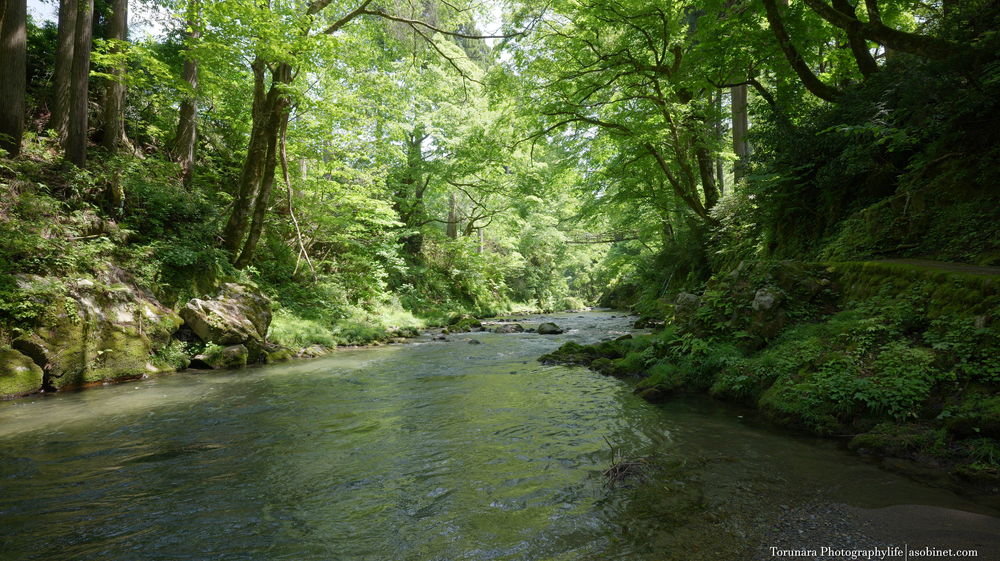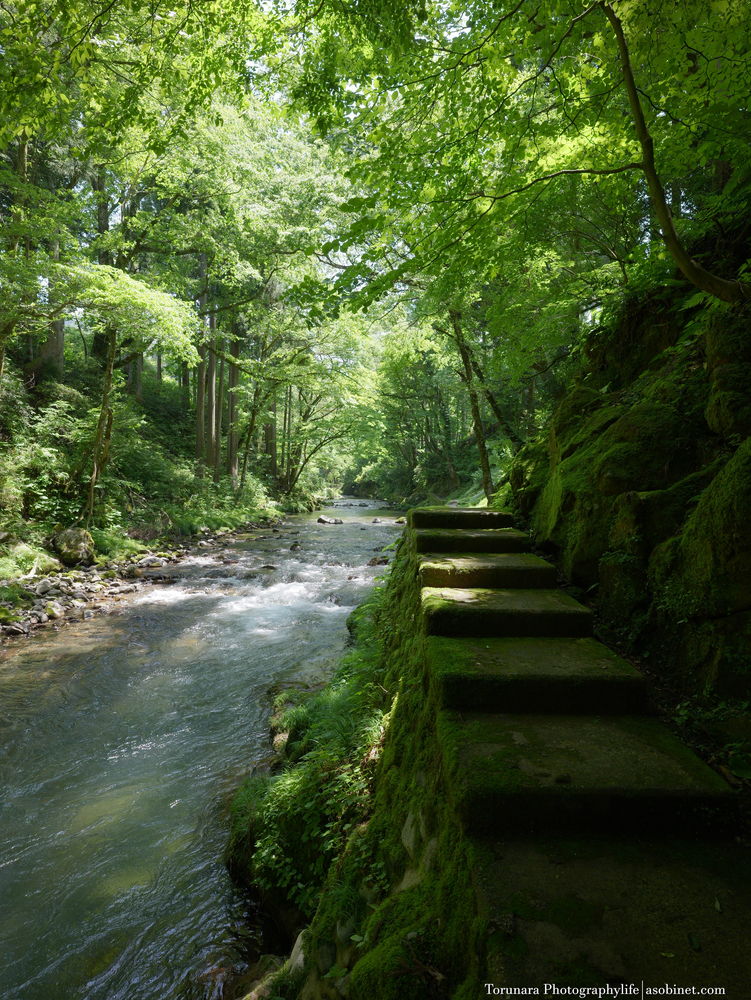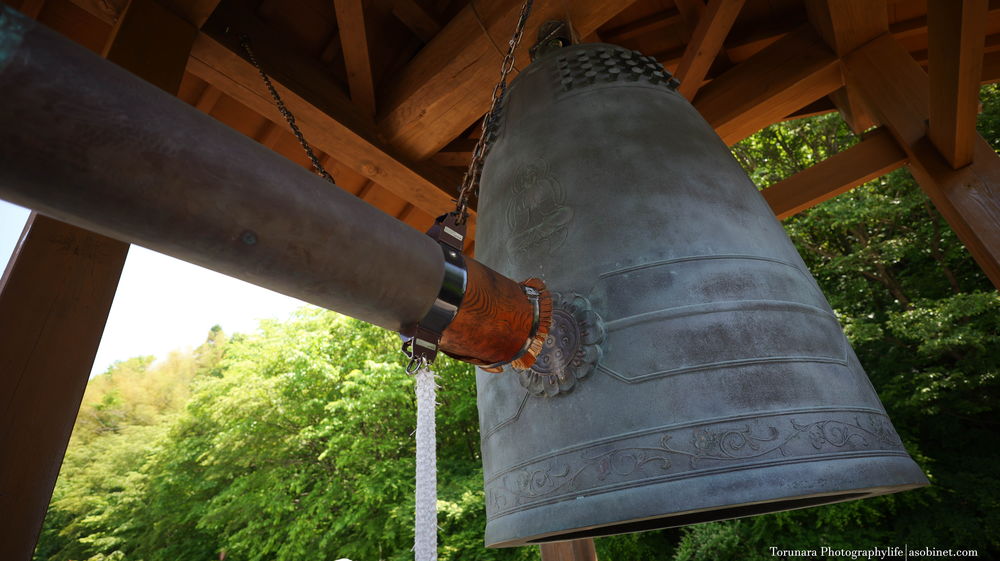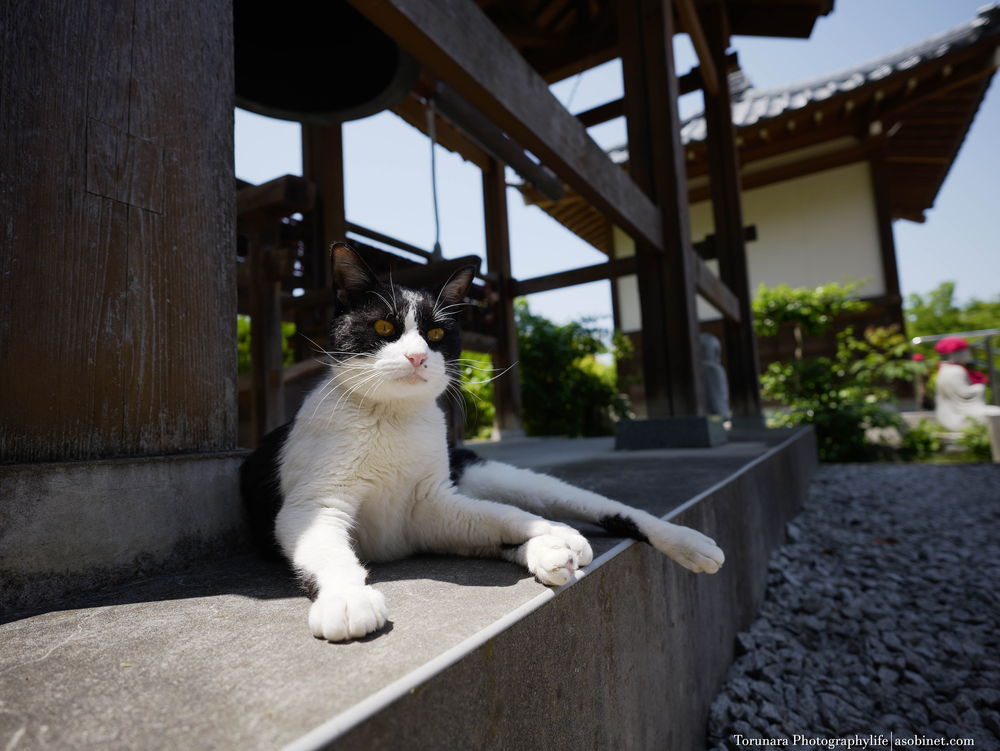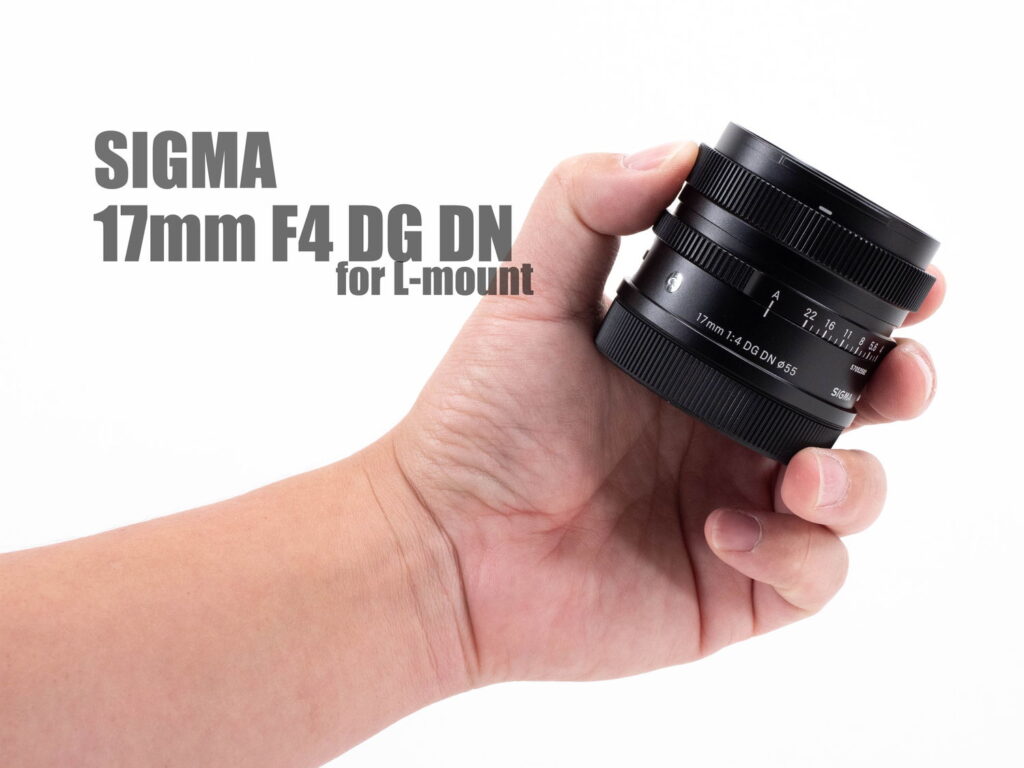This page contains reviews of 17mm F4 DG DN.
Lens Evaluation

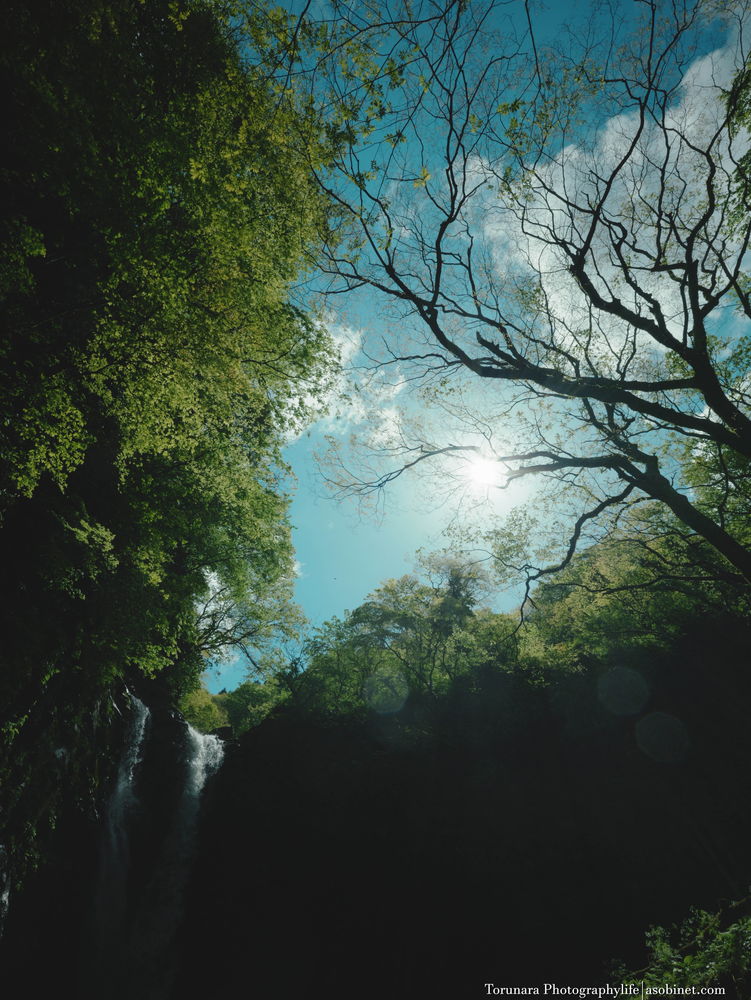


| Price | Higher than competing products |
| Size | Extremely compact |
| Weight | Extremely lightweight |
| Ease of use | Small but functional |
| AF performance | Slow speed, small angle of view change |
| Resolution performance | Very good throughout the entire focus range |
| Bokeh | Smooth background blur |
| chromatic aberration | Good correction status |
| distortion | Correction required |
| coma aberration | fairly good |
| Vignetting | Correction required |
| flare resistance | very good |
| Overall evaluation | High-performance 17mm with excellent portability |
Evaluation:
High-performance 17mm with excellent portability
A compact, lightweight, high-performance 17mm ultra-wide-angle lens. While there are an increasing number of wide-angle lenses available for mirrorless cameras, this one stands out for its build quality and optical performance. Although the price is on the higher side, it is one of the lenses I would strongly recommend.
The only competing product for the Sony E-mount is the Samyang “AF 18mm F2.8.” It is affordable, compact, and lightweight, and has a wider aperture than the Sigma. It is an attractive option with good value for the price, but it is important to note that the build quality is clearly inferior to the Sigma (there are many plastic parts and the overall feel is not very good).
Foreword
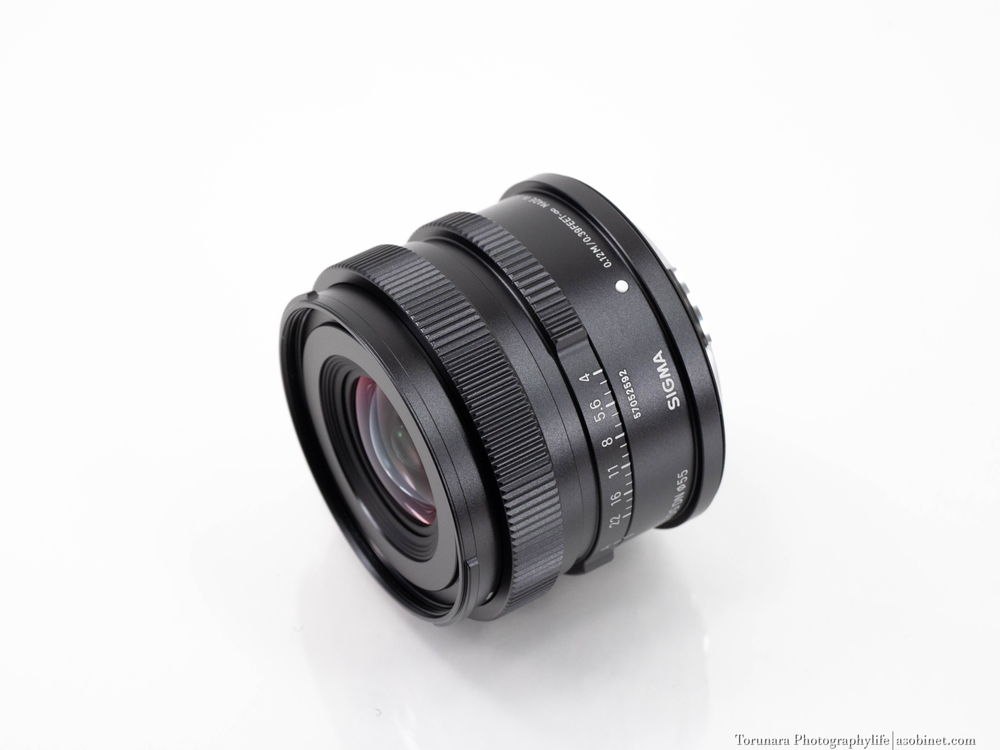
- Release Date:2023.04.03
- Product page
- My Flickr album
- Flickr Group Page
- Japanese user contribution site
- B&H photo
- Adorama
A wide-angle prime lens for Sony E and Leica L mounts, released in April 2023. Currently, it is the shortest focal length and widest angle of view among prime lenses in the Sigma DG DN series, including the I Series. Additionally, ultra-wide-angle compact AF lenses compatible with both Sony E and Leica L mounts are rare, with very few competing lenses available.
specifications
| lens mount | E / L |
| Supported sensor size | Full frame |
| focal length | 17mm |
| Lens construction | 8 groups of 9 pieces |
| Aperture | F4 |
| Aperture blades | F22 |
| Minimum focusing distance | 0.12m |
| Maximum magnification | 1:3.6 |
| Filter diameter | 55mm |
| image stabilisation | - |
| Teleconversion lens | - |
| Coating | Super multi coating |
| Size | φ64.0×48.8mm |
| Weight | 225g |
| weather sealing | Rubber sealing on mounting section |
| AF | stepping motor |
| Aperture ring | support |
| Other controls | AF/MF |
| Accessories | Magnetic metal cap hood |
Lens prices and how to buy them
Lens Review
Appearance and operability
Boxes and accessories
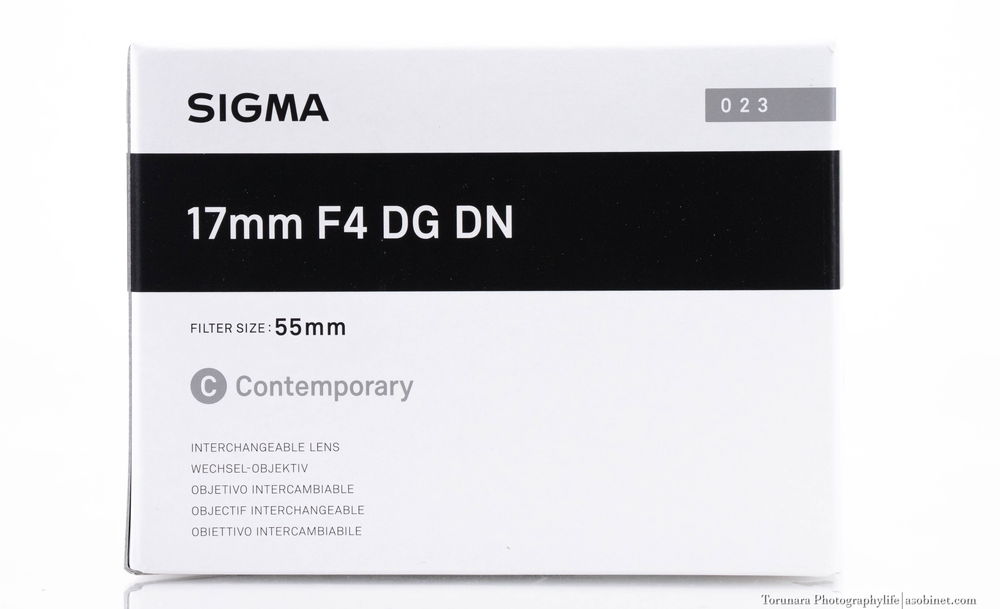
The SGV (Sigma Global Vision) series features a simple design based on black and white. Information such as the lens name, filter size, compatible mounts, and included accessories is displayed in a stylish manner. The three-digit number displayed in the upper right corner is the edition number, which uses the last three digits of the year of release. (This lens was released in 2023, so the number is “023.”)
Cardboard is used for partitioning, and no cushioning material is included. As this is not an Art or Sports line product, Sigma's original lens case is not included.

In addition to the lens body, a metal lens hood, lens cap, and magnetic metal cap are included.
Appearance

Although this lens belongs to the Contemporary line, it features a high-quality metal exterior typical of the I Series. Metal parts are used for the aperture and focus rings, with only a few plastic parts. It does not have the sleek design of Sony's ZA lenses, but it has its own appeal.The glossy central ring is a decorative element with no functional purpose. However, it provides a tactile feedback through the viewfinder, making it a useful point to rest your left hand when you don't want to touch the focus or aperture rings.
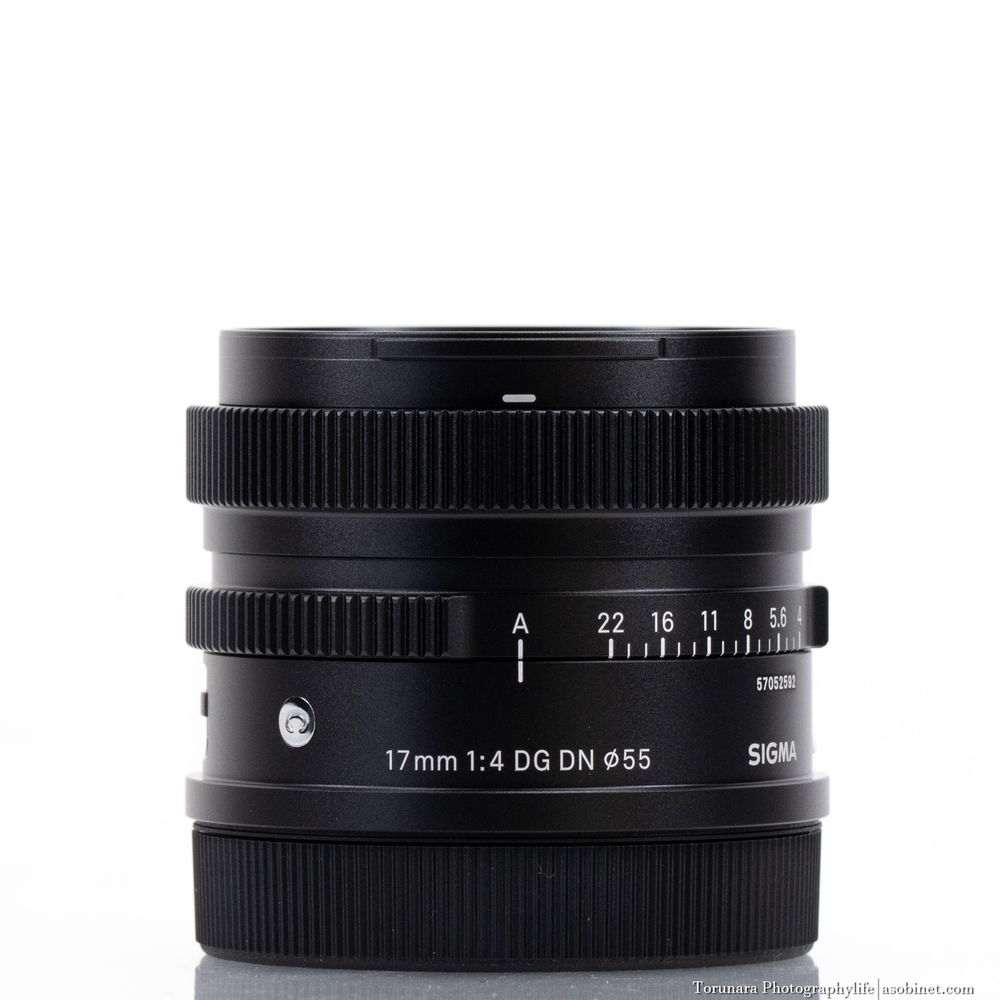
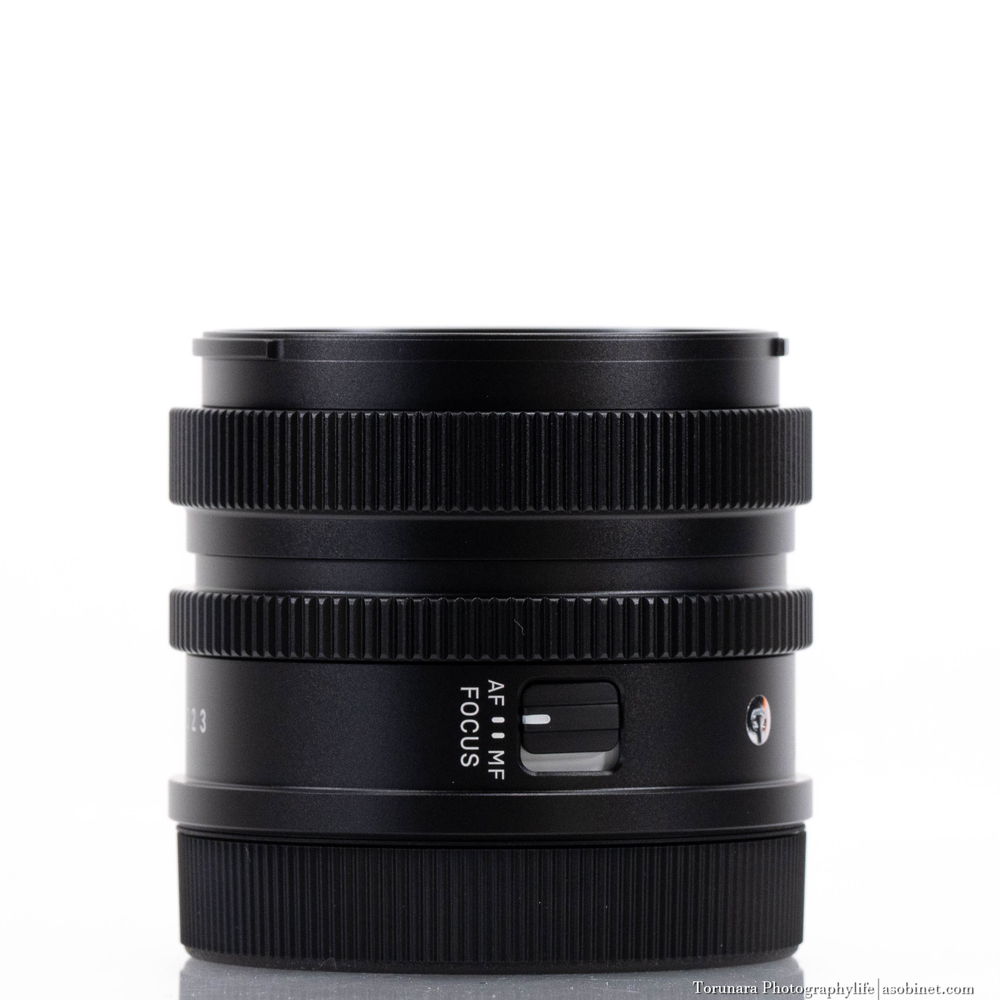
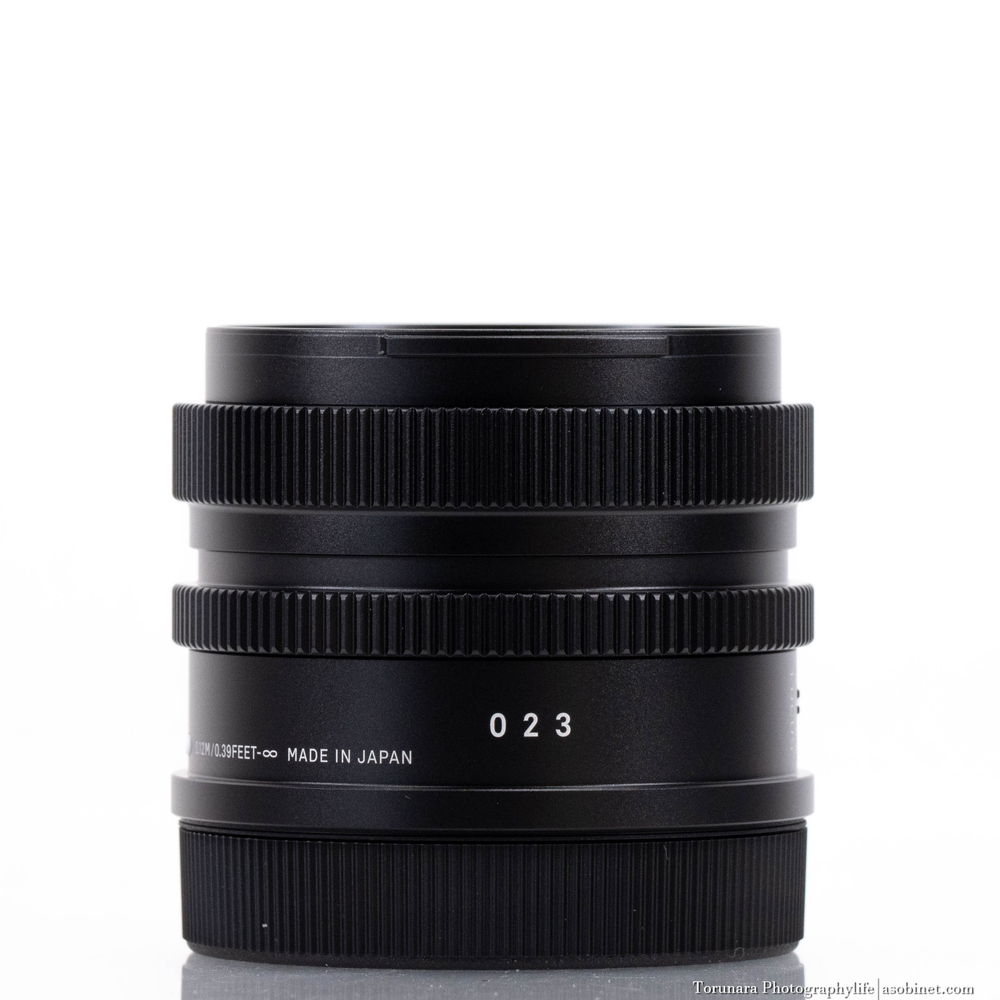
At first glance, the exterior markings appear to be printed, but when touched by hand, they feel like they are engraved with slight irregularities. Information such as the country of manufacture (Japan), edition number, and serial number is included.
Hands-on

As a full-frame compatible ultra-wide-angle lens, it is surprisingly compact and lightweight. Despite this, the metal barrel is sturdy and provides a sense of quality, stimulating a sense of pride in ownership. The lens design may be a matter of personal preference, but I personally like it. The exterior has a matte finish that is resistant to scratches and fingerprints. Unlike the larger I Series lenses, it does not feature a glossy decorative ring.
Front and back
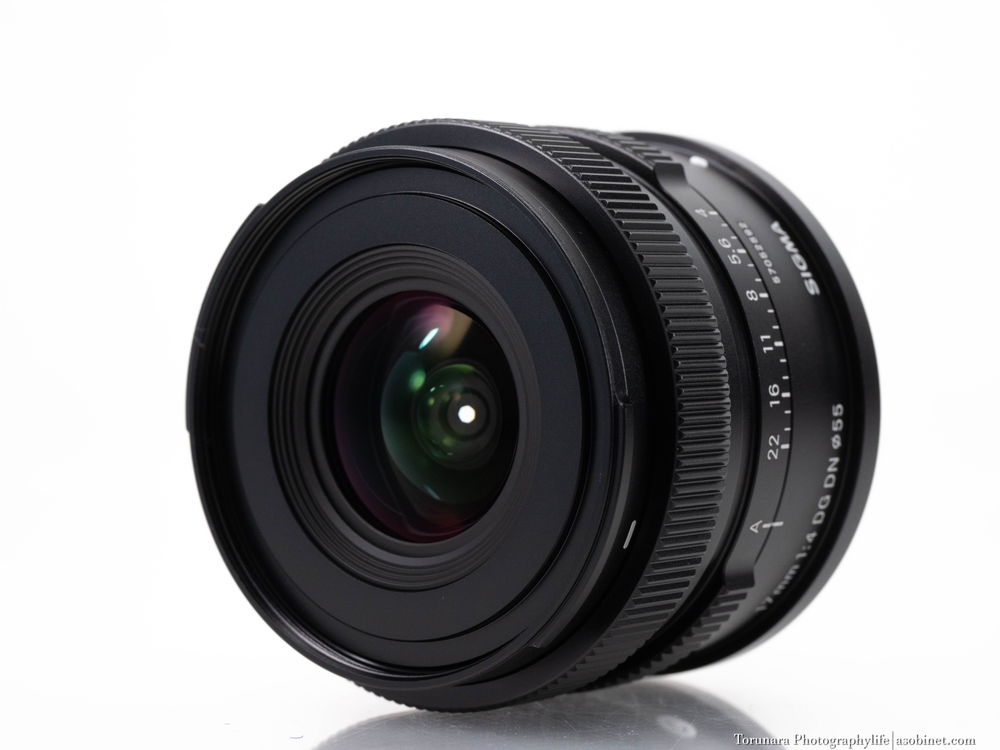
The front of the lens also features metal parts. Its unique shape is designed to fit a special magnetic metal cap. While other manufacturers print the lens name and filter size on the front, Sigma lenses have a simple design. White lettering can reflect light, so we believe Sigma's design is preferable.The filter size is compatible with a 55mm diameter. While the large-aperture I Series does not have a unified filter diameter, the compact I Series adopts a 55mm diameter for many lenses (24mm F3.5, 45mm F2.8, 90mm F2.8). Additionally, some lenses designed for APS-C cameras also use a 55mm diameter, making it a versatile filter size for various applications.
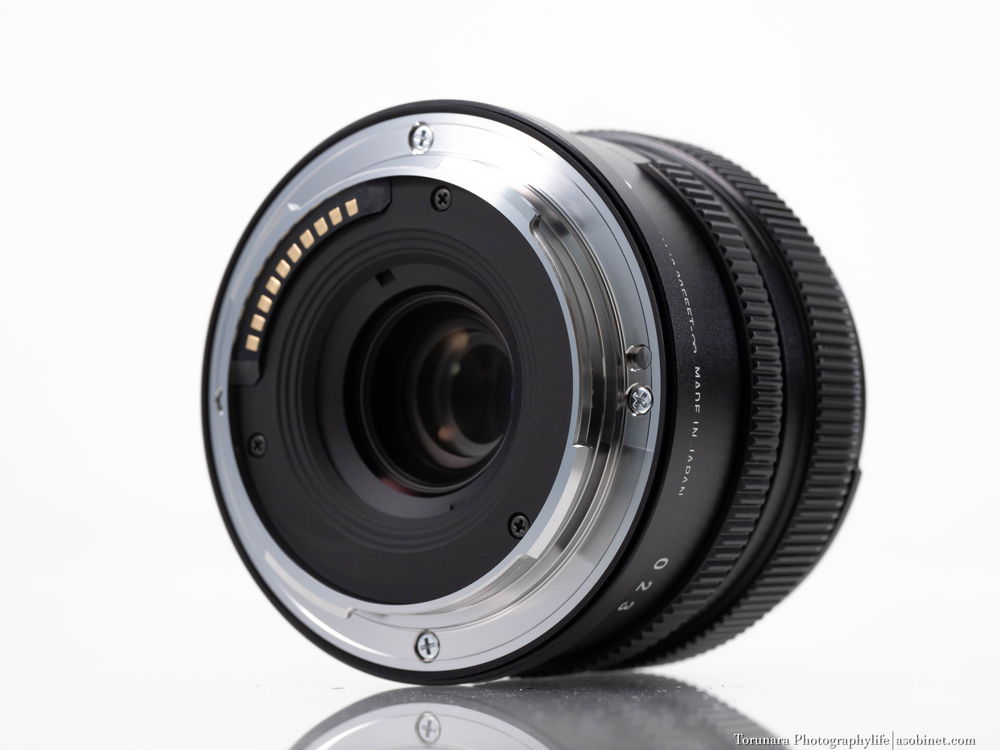
The brass lens mount is secured with four screws. There is a simple dust and splash proof seal around the mount. The seal makes it somewhat difficult to attach to the camera. The rear lens area is painted black to prevent reflection, and there appear to be no parts that would reflect unnecessary light.
Focus ring
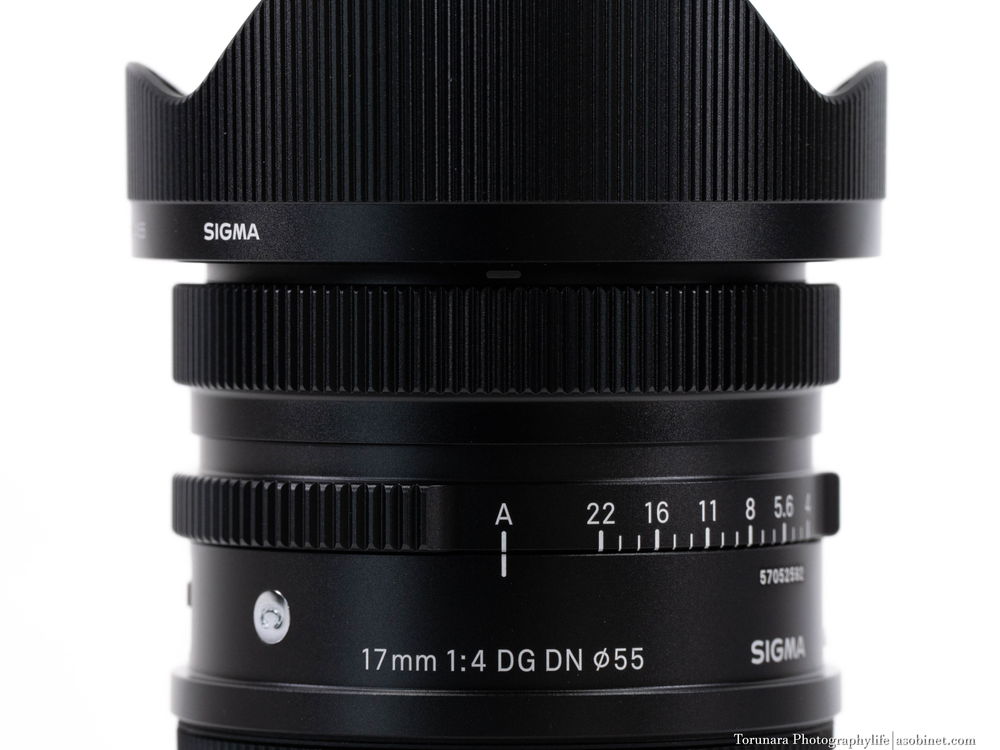
A metal focus ring is positioned at the front of the lens. Compared to Sony's standard lenses, which have a looser feel, this lens offers a more resistant operation, providing a smooth, buttery feel similar to Panasonic's LUMIX S lenses.
The Sony E-mount version supports non-linear response only. The Leica L-mount version allows switching between linear and non-linear response when paired with compatible cameras. In linear mode, adjustments are possible in 30-degree increments within a range of 120 to 720 degrees (LUMIX S5II). In non-linear mode, quick rotation allows operation up to 90 degrees, and slow rotation allows operation up to less than 180 degrees.
Aperture ring
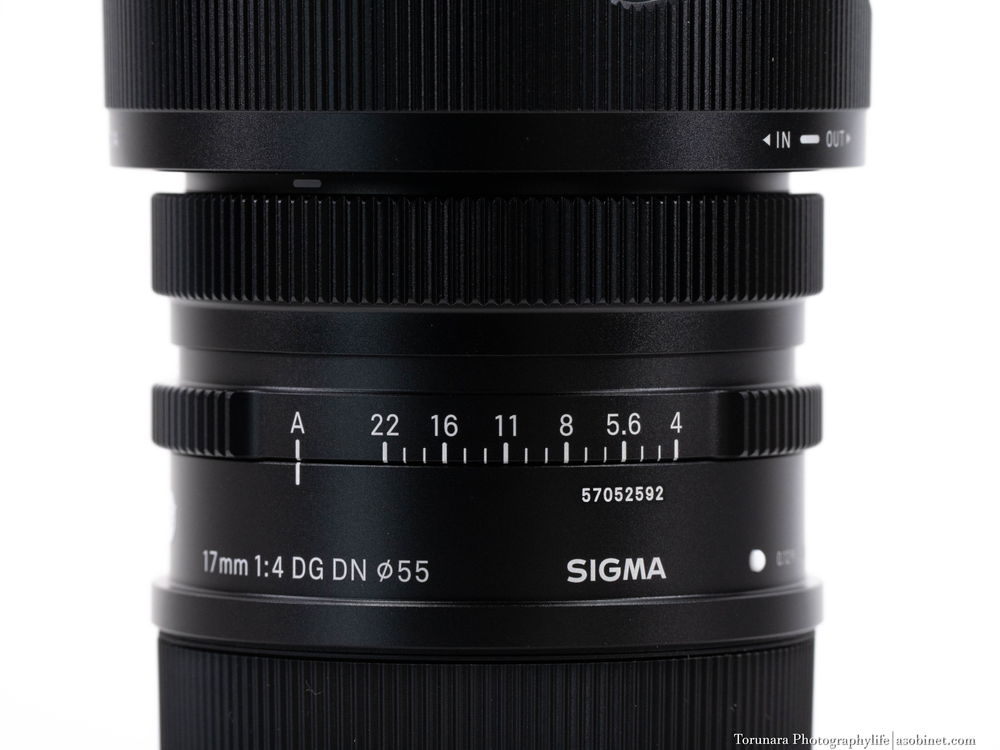
A metal lens hood is included that offers a quality feel comparable to the main body. It does not have the stylish impression of Sony ZA lenses, but considering the design of the main body and the company's own camera (fp), this may be the optimal solution. The lens hood can be attached upside down, but access to the focus ring is almost impossible.
Example of use
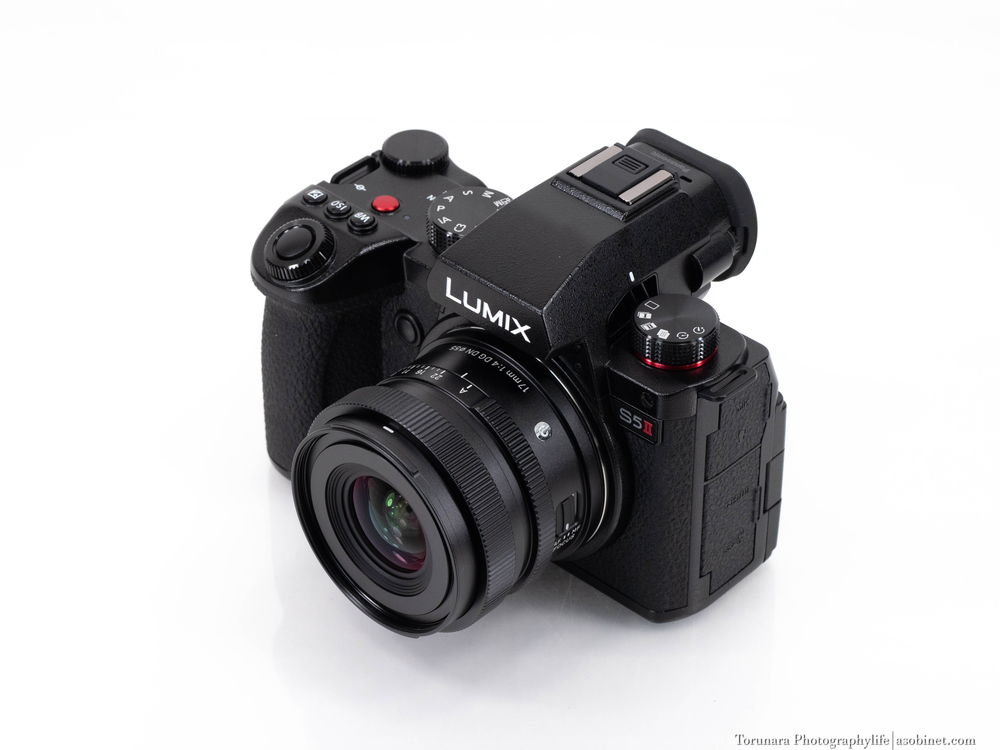
Mounted on the LUMIX S5II. The lens is compact and lightweight, so the center of gravity does not shift excessively forward, allowing for balanced handling. It is easy to hold the camera with one hand. The ultra-wide-angle lens is particularly useful for shooting from various angles, and the ability to maintain a low or high angle with one hand is a major advantage. There is ample space between the grip and the lens, allowing for comfortable operation of the focus ring and aperture ring with the left hand.
AF・MF
Focus Speed
This lens features inner focusing driven by a stepping motor. Autofocus is smooth and reasonably fast. While the AF speed is acceptable, it appears to be slightly slower than expected for an ultra-wide-angle lens. It is unclear whether Sony E-mount will offer faster AF. As mentioned later, focus breathing is virtually non-existent, resulting in very natural-looking focus shifts.
Breathing
Focus breathing refers to the change in the angle of view depending on the focus position.If the change in angle of view is significant, the field of view will expand or contract during focusing, potentially causing distractions and affecting autofocus stability. Ideally, it is better to have no focusing breathing. In order to check the effects of breathing, we took the following photos with the lens stopped down to the minimum aperture, at the minimum shooting distance and at infinity.Although the angle of view does not remain completely unchanged, it is well controlled for a lens with a short minimum shooting distance. The small change in angle of view allows for dynamic shooting with a wide angle of view even when shooting close-ups.
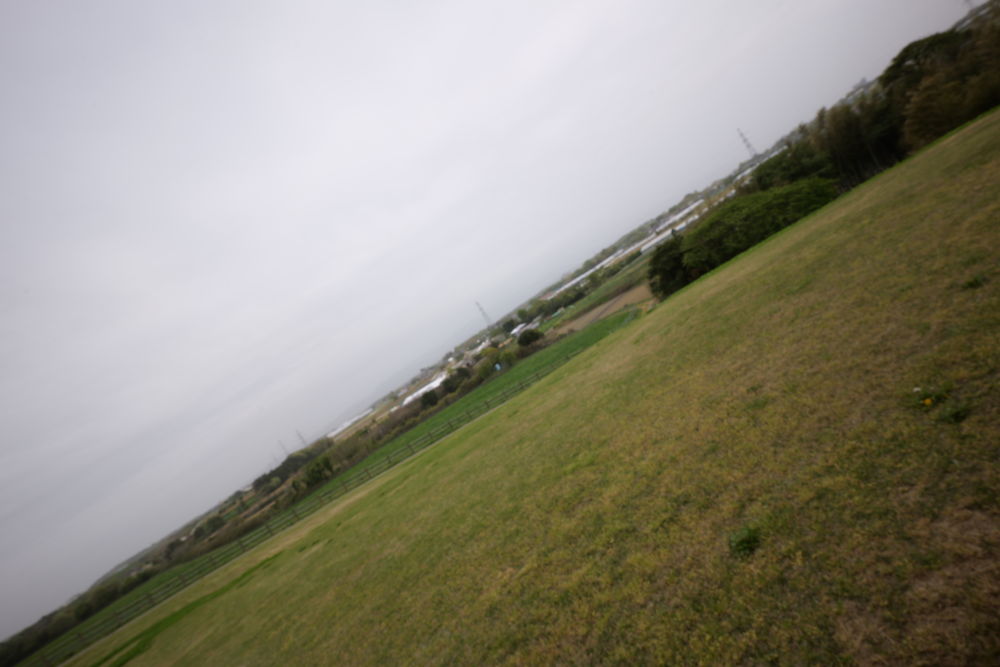
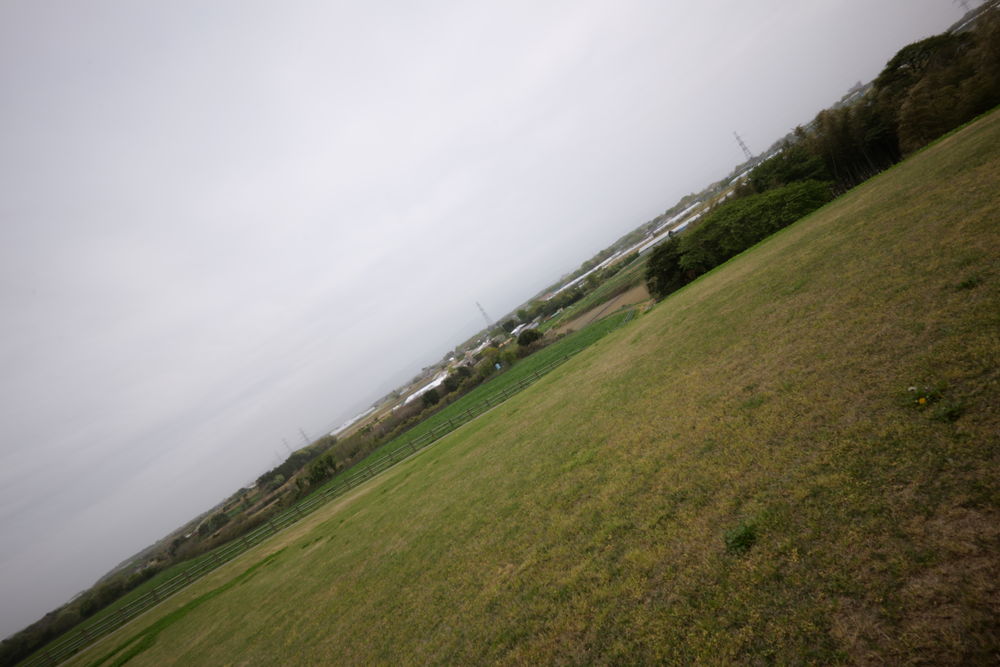
AF accuracy
Although I did not notice any problems with the AF accuracy of the lens, the camera (LUMIX S5II) misdetected the focus, resulting in an out-of-focus image. I felt that caution is necessary in situations where mistakes are not allowed.
MF
In the case of non-linear response, you may feel that the stroke for fine adjustment is short. However, the shortest shooting distance and infinity are set with a longer stroke than other focus positions. Personally, I find a setting of around 180 degrees with linear response to be just right.
Resolution Chart
Test conditions
- Camera body:LUMIX S5II
- Interchangeable lens:17mm F4 DG DN
- Pearl Optical Industry Co.
‘[HR23348] ISO12233-compliant 8K resolution test chart (for still cameras)’ - Olympus HYRes 3.1 analysis software
- The lighting environment is constant indoors.
- Tripod, self-timer 10 seconds, electronic shutter
- RAW output
- ISO 100
- RAW development in Adobe Lightroom Classic CC
・Sharpness: Off
・Noise reduction: Off
・Chromatic aberration correction: Off - Focus on each point to be analysed and take a picture
(image plane curvature is difficult to measure at close range, so check at infinity) - Note that this is a test at close range (infinity may be even better).
- If you adjust the sharpness when developing JPEG or RAW images, the values may improve. Please note that the values given here are the ‘minimum values’.
Test results
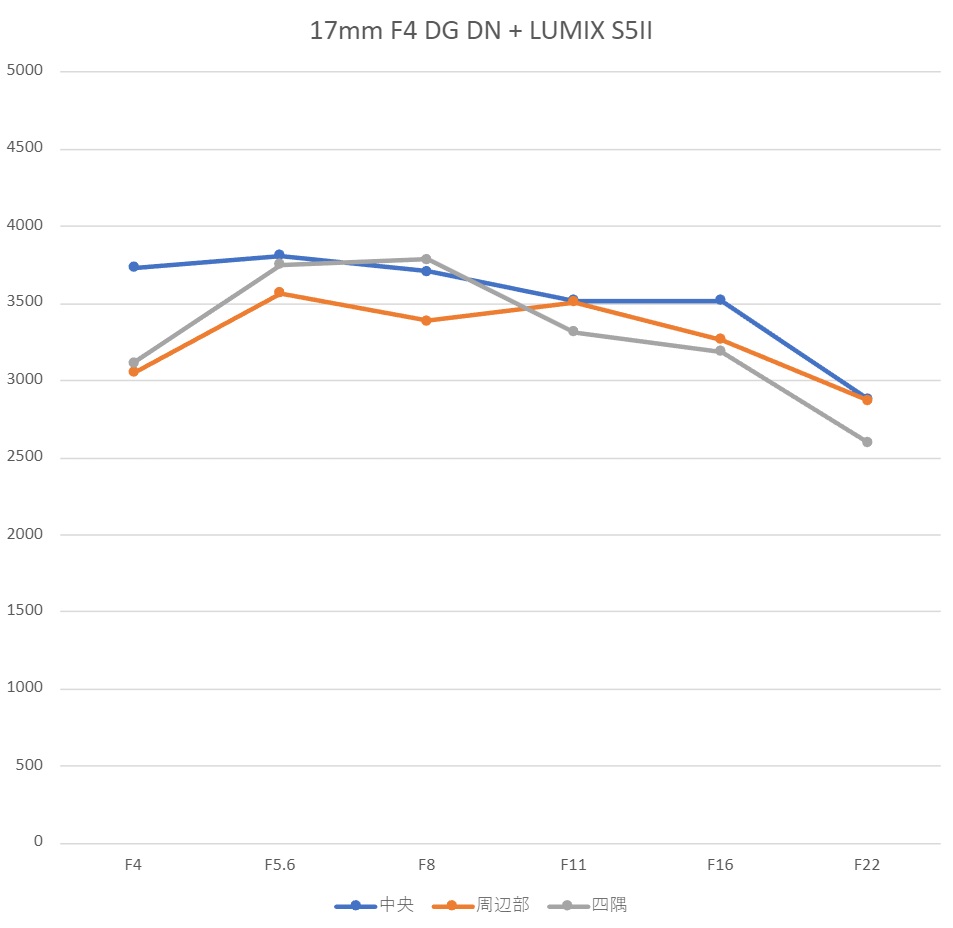
I Series lenses tend to exhibit increased spherical aberration and other aberrations during close-up shooting, resulting in a decrease in resolution performance. While this lens also shows such tendencies in the corners of the frame, the decrease in image quality is milder compared to other lenses. At least with the 24-megapixel LUMIX S5II, good results can be achieved overall from F4 onwards.
Centre of frame
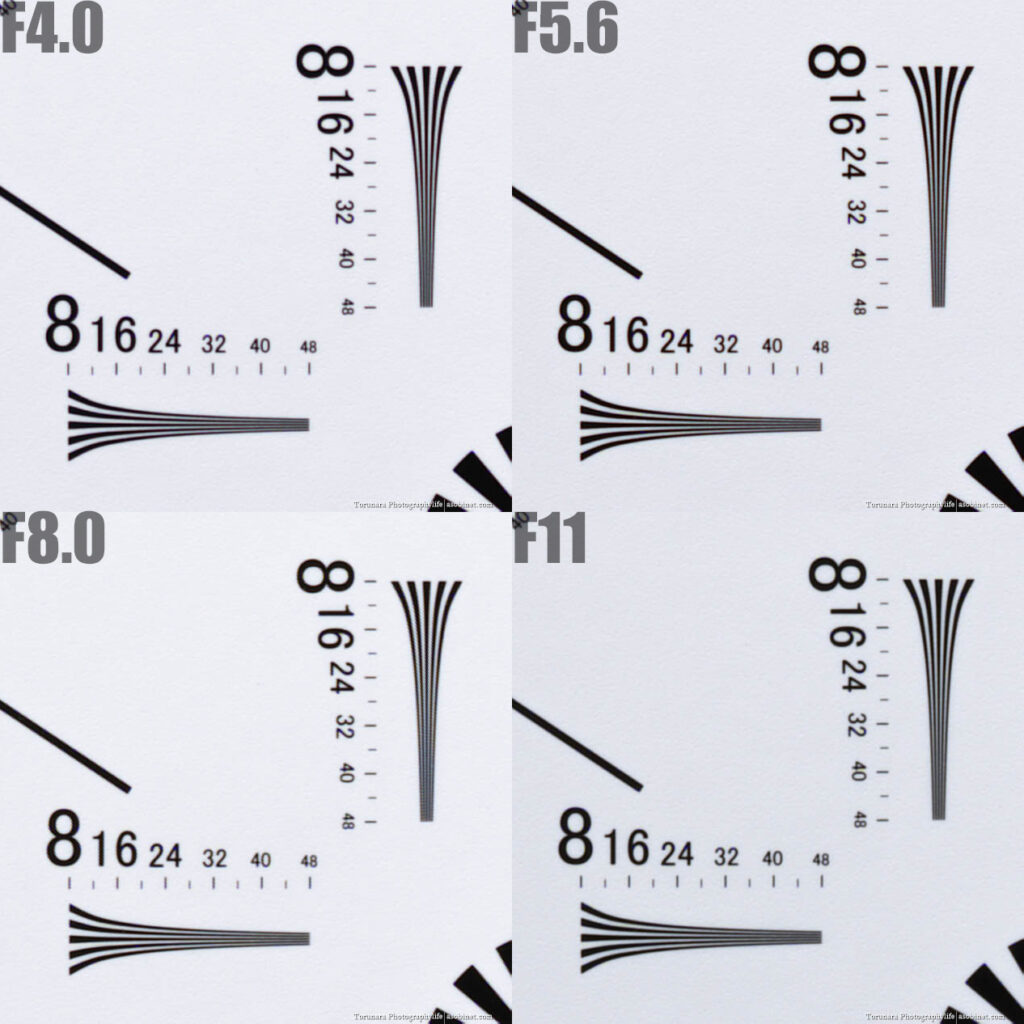
You can achieve sharp results with high contrast from F4. It can resolve at least 4,800 lines, which is the upper limit of the resolution chart, and there is no significant change even when the aperture is stopped down. It appears to have sufficient resolution performance to withstand cameras equipped with high-resolution sensors of 45 million pixels or 61 million pixels.
Although there is a slight decrease in contrast with F4, the resolution performance is very good. Furthermore, stopping down to F5.6 improves contrast and produces results closer to the center.
Middle of frame
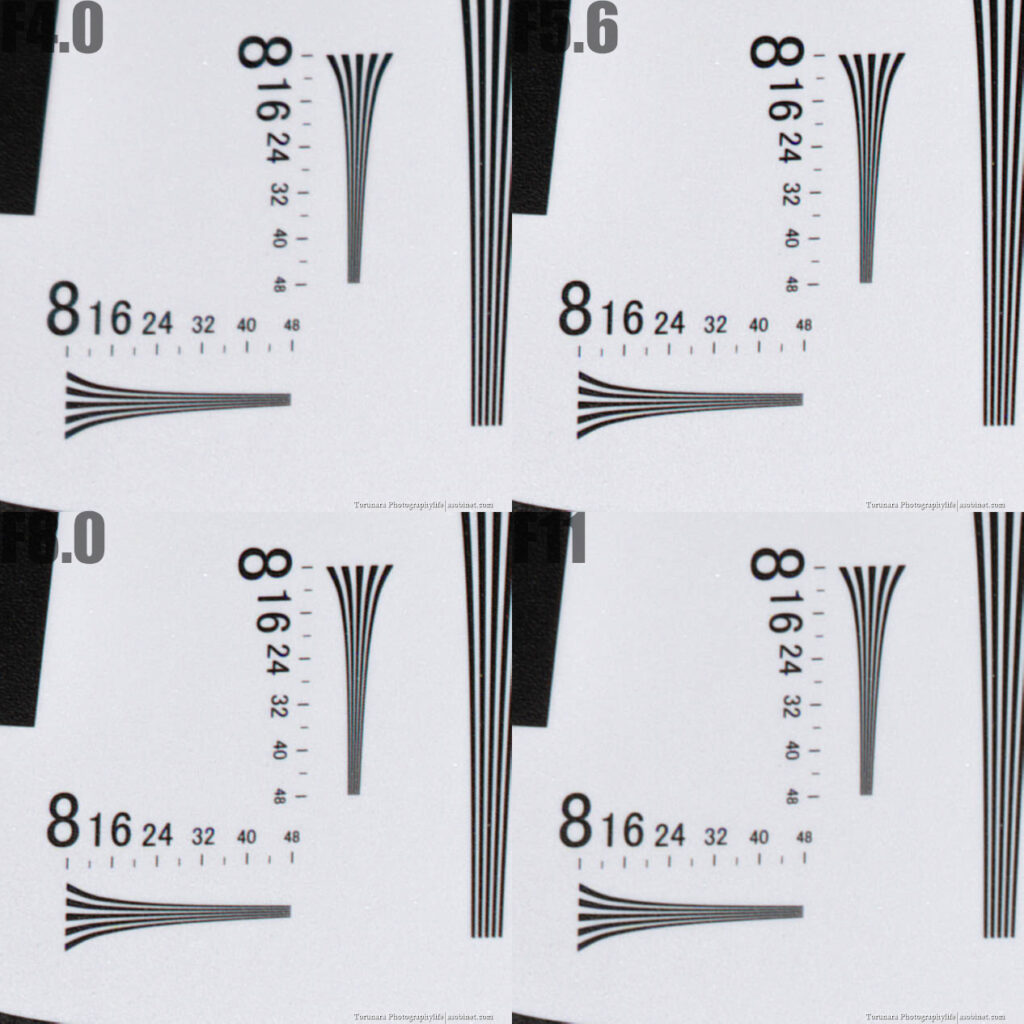
At F4, the peripheral areas are softer, but the wedge shape appears to be well resolved. Furthermore, as you stop down toward the peak at F8, the contrast improves. Visually, I would say it is around 4000 to 4500 lines.
Four corners of frame
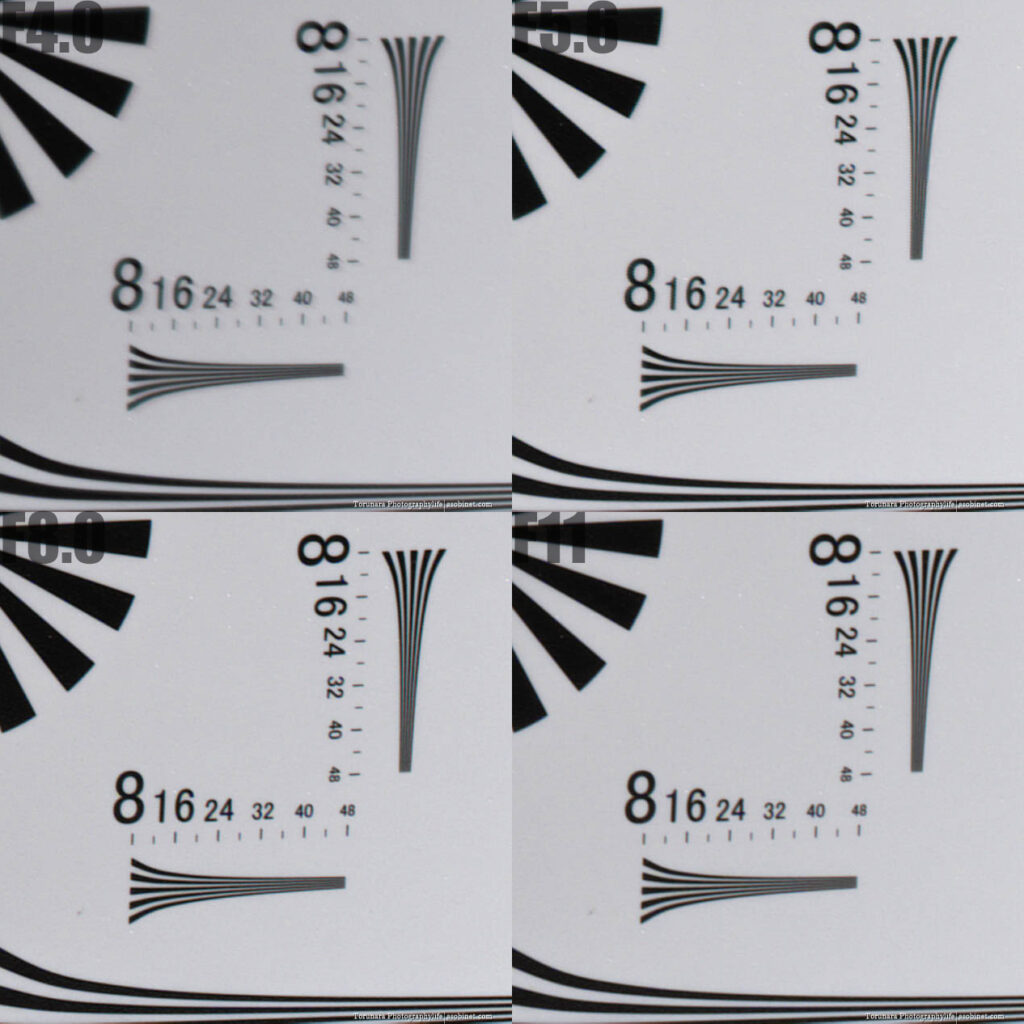
At F4, the peripheral areas are softer, but the wedge shape appears to be well resolved. Furthermore, as you stop down toward the peak at F8, the contrast improves. Visually, I would say it is around 4000 to 4500 lines.
Sample
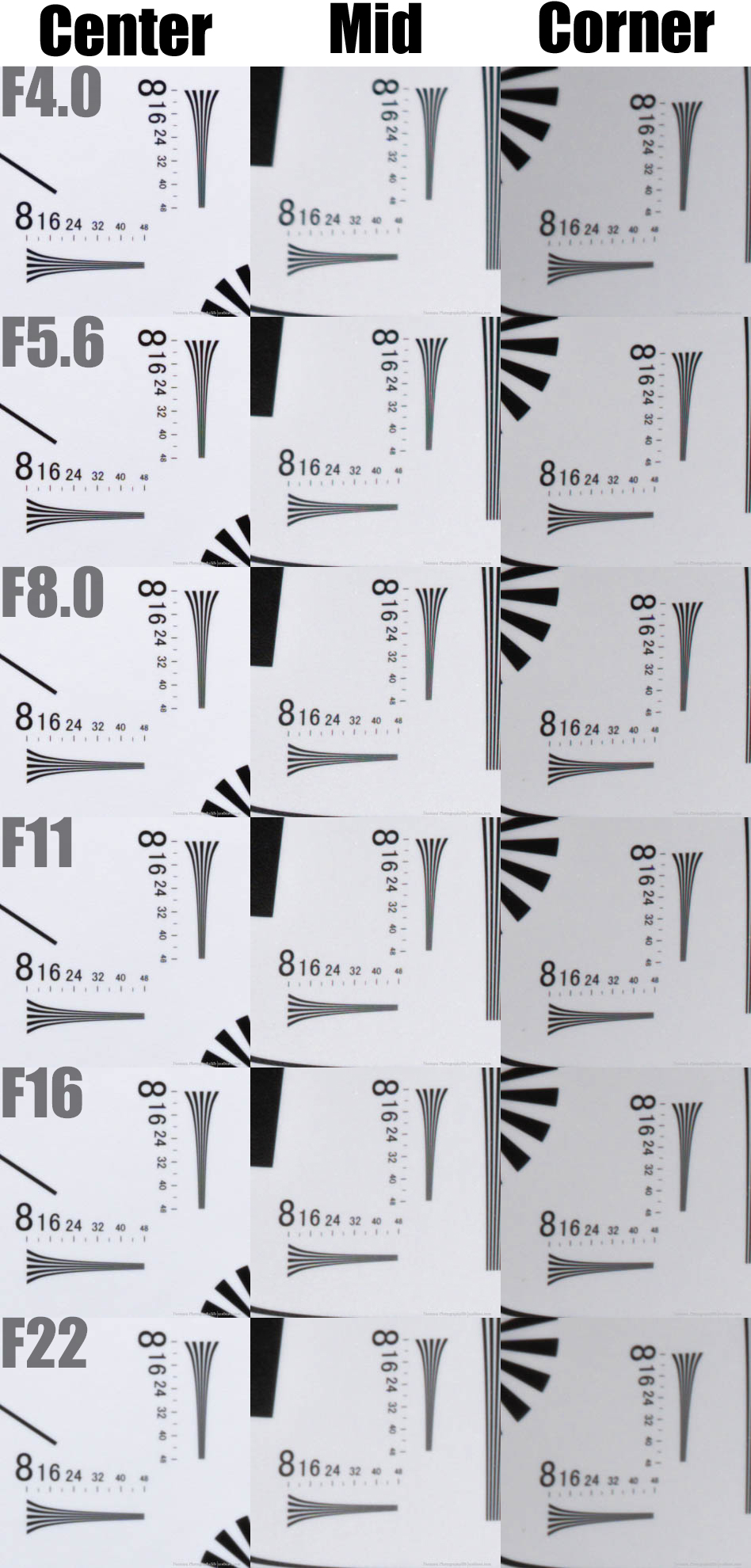
far-field resolution
Test environment
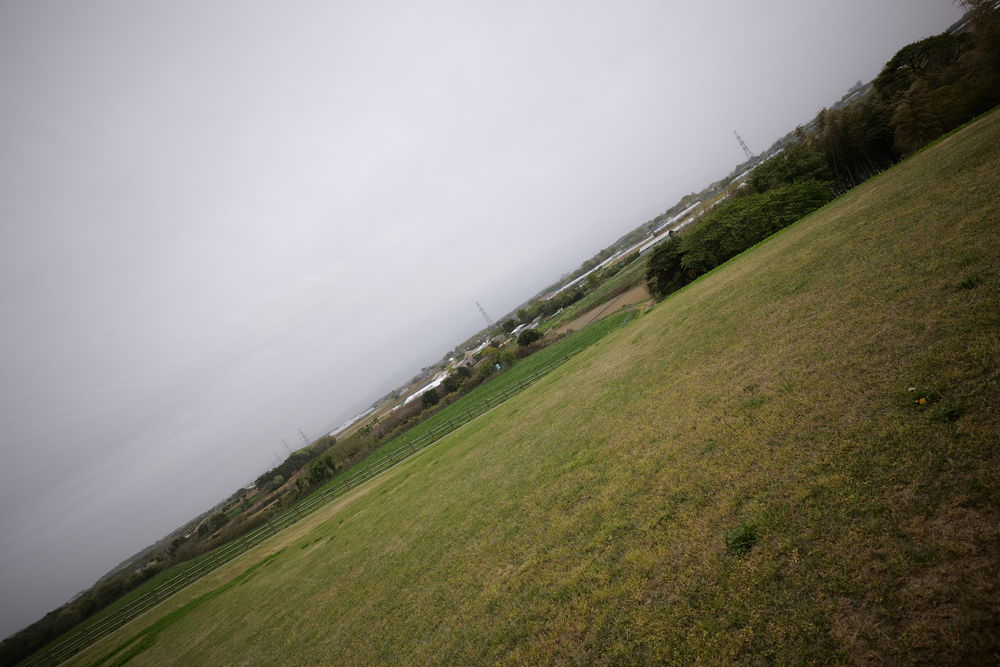
- Date of shooting: 2023.04.21 Cloudy, strong wind
- Camera: LUMIX DC-S5M2
- Tripod: Leofoto LS-365C
- Head: SUNWAYFOTO GH-PRO II
- Exposure: ISO 100 Aperture priority AE
- • Normal F4-F22
- • High-Res: F4-F11
- RAW: Adobe Camera RAW
- • Sharpness Off
- • Noise Reduction Off
- • Lens Correction Off
Test results
You can achieve good results from F4 aperture to the edge of the frame. Stopping down improves the results slightly, but at least with the 24-megapixel LUMIX S5II, F4 can be considered peak image quality. Similar results can be achieved up to around F11, with image quality deteriorating due to diffraction at F16 and beyond.
Centre of frame
Even in high-resolution mode with 96 million pixels, practical sharpness and contrast can be obtained from F4. When the aperture is narrowed, the contrast increases slightly, but basically peaks at F4.
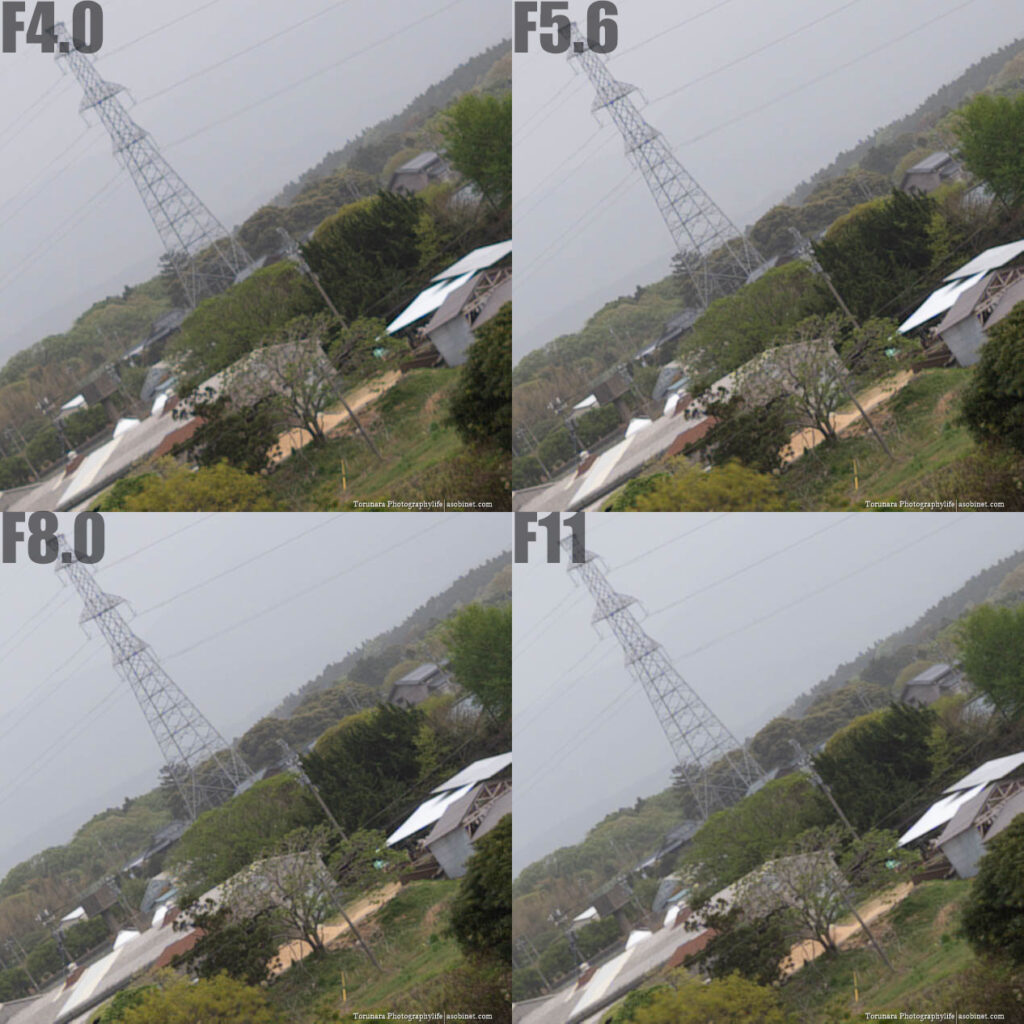
Middle of frame
Compared to the center, there is some softness such as astigmatism, but by stopping down to F5.6-F8, it is possible to obtain sharp results close to the center. F8 is best, but F5.6 is also sufficiently good.
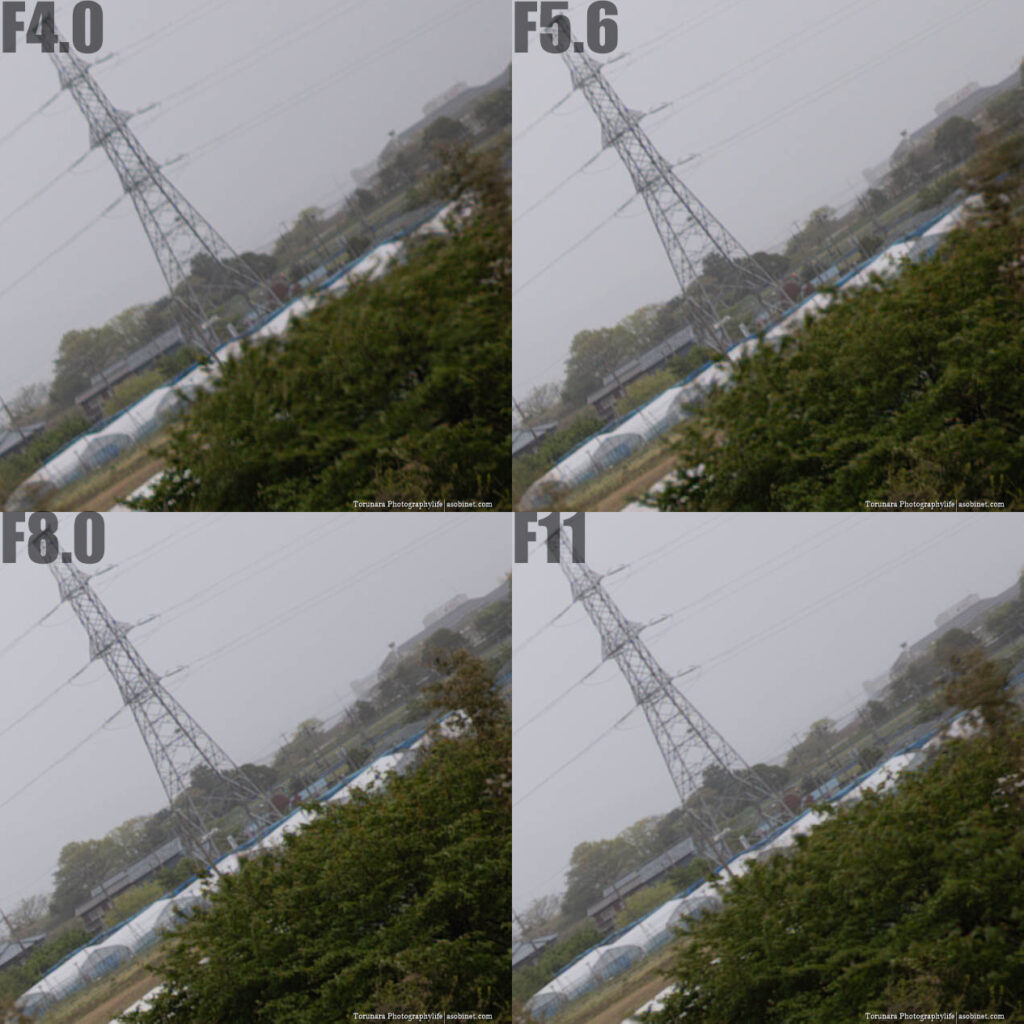
Four corners of frame
Although peripheral light falloff is noticeable, there is no significant deterioration in image quality compared to the peripheral areas. Stable results can be obtained from F4, but if possible, it is recommended to stop down to F8 for better results.
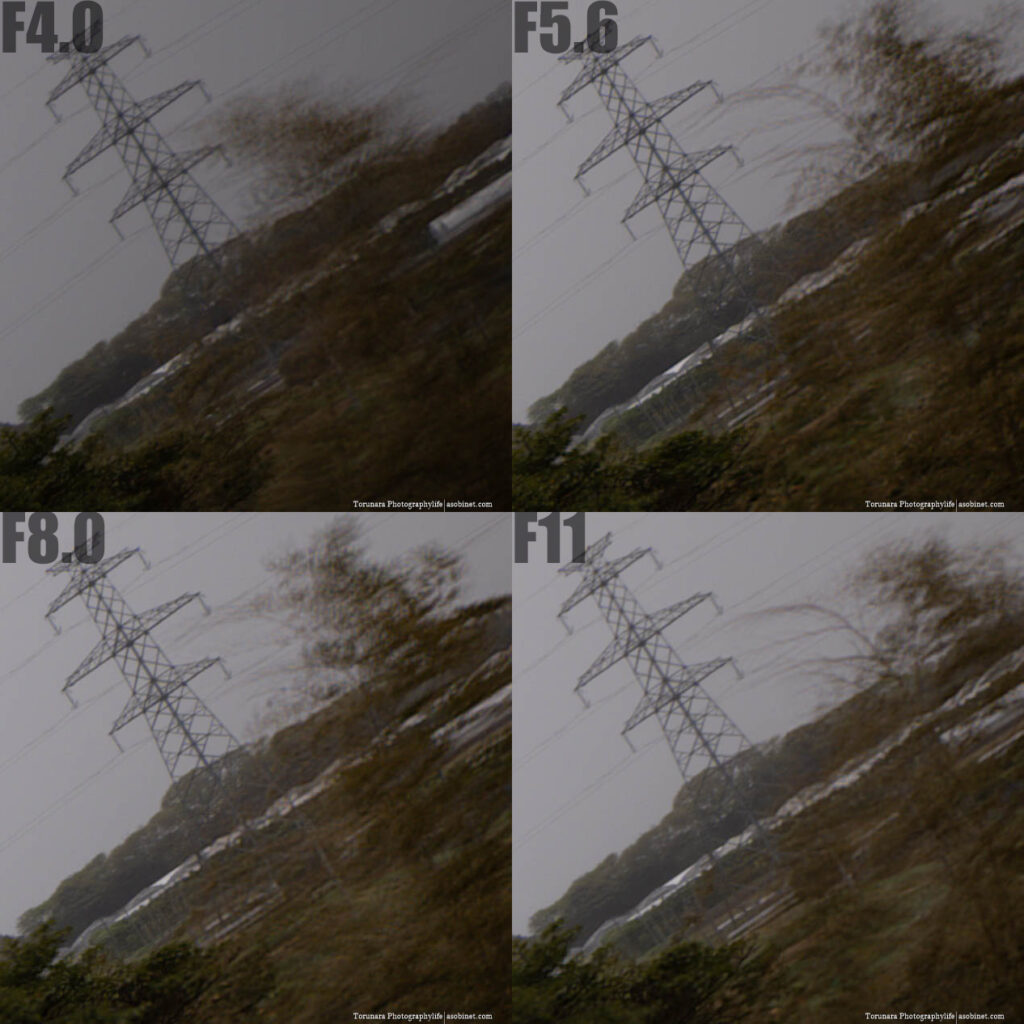
curvature of a surface
What is surface curvature?
This refers to the fact that the shooting distance at which the image is in focus differs from the centre to the four corners. For example, even if the image is in focus at a shooting distance of 1m, if the subject is moving back and forth around 1m at the edge of the frame, there is a possibility of field curvature.
Although there are few lenses that have noticeable field curvature, in recent lenses, aberration may increase and become noticeable at close distances. However, there are few opportunities to take photos of flat subjects at close range, so even if there is some image curvature, there is no need to worry.
However, if there is an effect even at infinity, you should be careful. If you are trying to achieve a pan-focus effect, for example in a landscape, there is a possibility that you will end up with an unintentional out-of-focus image. As there is no way to correct this aberration, the only way to avoid the problem is to increase the F-number to widen the depth of field.
Test results
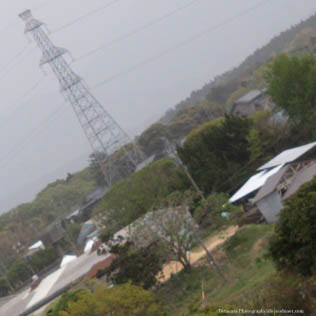
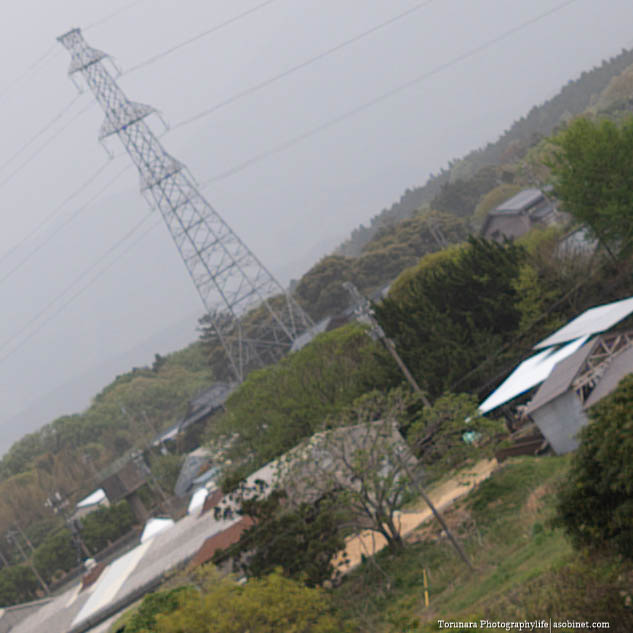
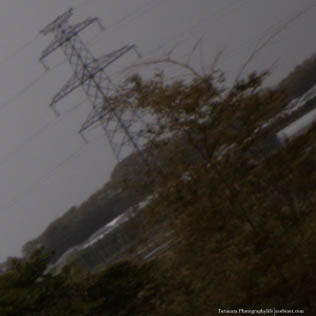
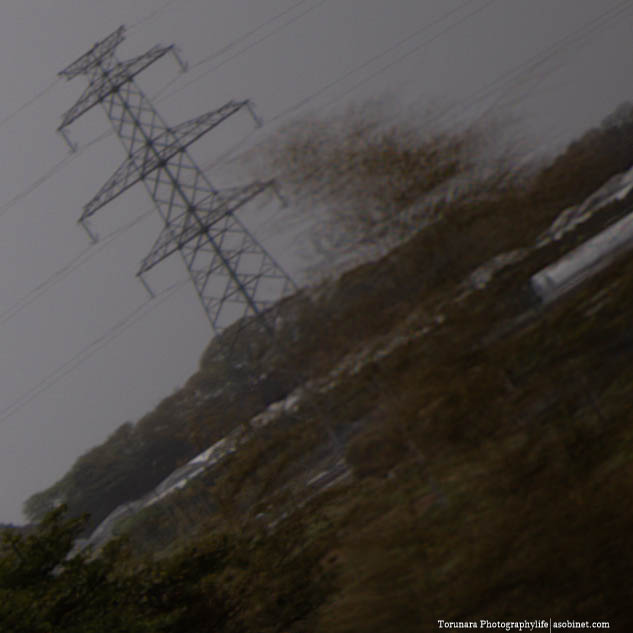
Lateral chromatic aberration
What is lateral chromatic aberration?
A colour shift that appears mainly around the edges and corners of the frame. Unlike longitudinal chromatic aberration, the effect of correcting this aberration using the aperture is small, so it is necessary to correct it at the stage of optical design. However, it is possible to digitally correct chromatic aberration using the image processing engine built into the camera body. This makes it possible to correct chromatic aberration, which is difficult to correct optically alone, and recently, there have been lenses that prioritise the correction of other aberrations over chromatic aberration correction. In particular, mirrorless systems tend to rely on post-processing.
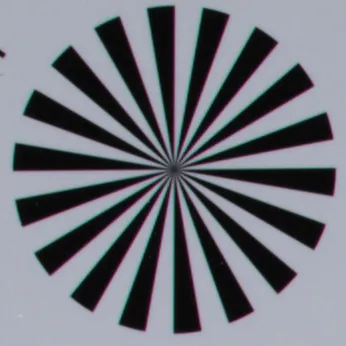
Test results
At least when developing LUMIX S5II RAW files in Adobe Camera RAW, chromatic aberration appears to be well suppressed. It is unclear whether mandatory corrections are applied by the correction profile. Even if corrections are applied, the contrast in fine details appears to be good, and there do not appear to be any major issues.
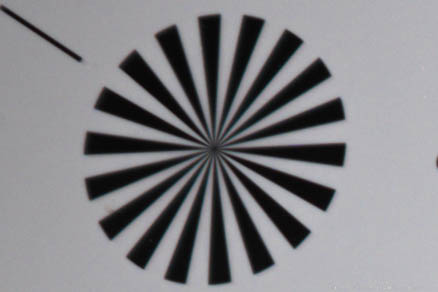
Longitudinal Chromatic Aberration
What is longitudinal chromatic aberration?
Longitudinal chromatic aberration is a colour shift that occurs in front of and behind the plane of focus. If the area in front of the plane of focus is mainly purple fringing, and the area behind the plane of focus has unnatural green colouring in the out-of-focus area, then the main cause is likely to be longitudinal chromatic aberration. This is more likely to occur with large-aperture lenses such as F1.4 and F1.8, and in such cases it is necessary to close down the aperture to improve the situation. It is possible to correct this using development software, but it is more difficult to process than lateral chromatic aberration, so it is best to suppress the aberration optically if possible. However, when suppressing longitudinal chromatic aberration with a large-aperture lens, the product price tends to be higher. Lenses that perfectly correct for longitudinal chromatic aberration have high contrast on the focal plane from wide open aperture, so you can expect a punchy resolution.
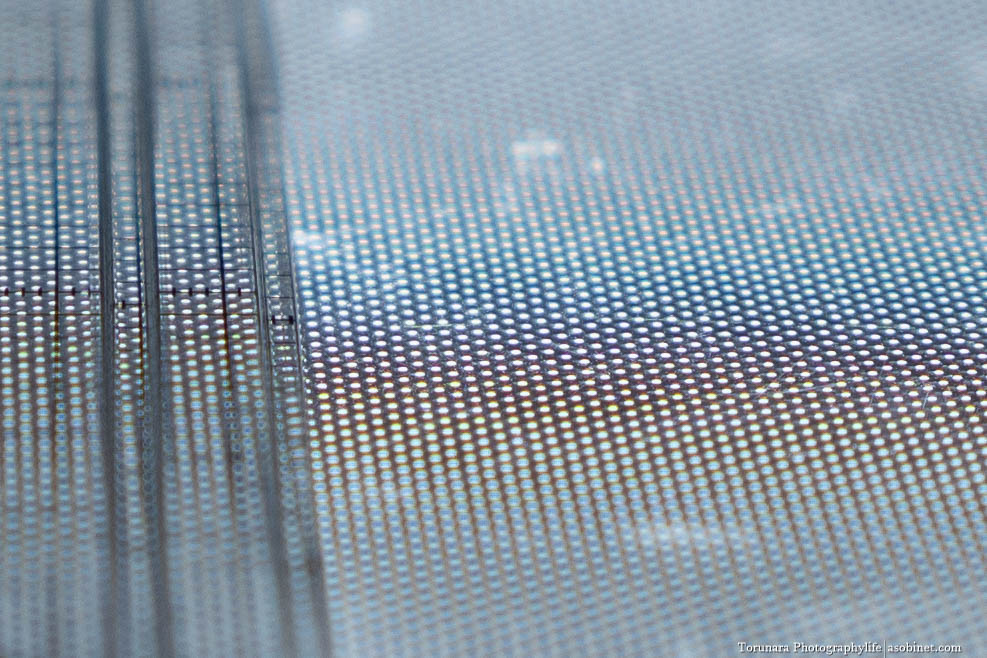
Test results
There are no noticeable problems with axial chromatic aberration from the maximum aperture of F4.
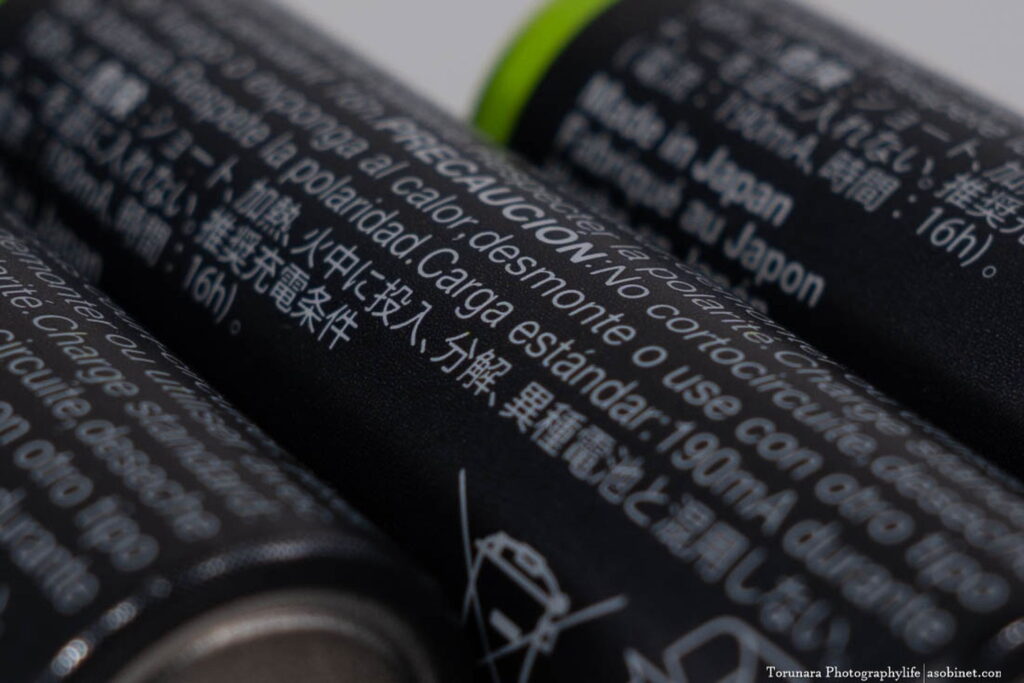
Distortion
What is Image Distortion?
Distortion refers to the phenomenon where straight lines do not appear straight on a flat surface. It is particularly noticeable when there are many straight lines, such as when there are man-made objects or a horizon in the image, and it can be divided into two types: barrel distortion, which is similar to that of a fisheye lens, and pincushion distortion, where the centre of the image appears compressed.
This is an aberration that can be corrected relatively easily, but it is difficult to manually correct distortions with complex shapes. In this case, a correction profile that matches the lens is required.
Test results
In uncorrected RAW files, barrel distortion is somewhat noticeable. As is common with wide-angle lenses for mirrorless cameras, the optical design assumes electronic correction by the camera or development software. For an ultra-wide-angle lens designed for compact, lightweight mirrorless cameras, the distortion appears to be better controlled than expected. However, due to the presence of pincushion distortion, manual correction is likely to be difficult.Correction using a correction profile is likely required.
Additionally, while correction using a profile results in a clean fix, it is important to note that significant cropping occurs compared to uncorrected RAW files. (However, the stated field of view should correspond to the corrected value.)

Coma aberration
What are coma and astigmatism?
Coma and astigmatism are mainly the failure of a point of light to appear as a point of light in the four corners of the frame. For example, this can be seen in artificial lights, stars and illuminations in night scenes. Even during the day, bright point light sources such as sunlight filtering through trees can also have an effect. As this problem cannot be corrected in post-processing, it is necessary to correct it optically.
Although it can be improved by narrowing the aperture, in situations where shutter speed is important, such as night scenes and astrophotography, it is not possible to narrow the aperture, and optical correction may be necessary.
Test results
Although not extremely noticeable, residual aberration can be seen in point light sources at the corners of the frame. To suppress this, it is necessary to stop down to around F5.6-F8. This is consistent with the tendency for contrast at the corners to improve in distant shots.
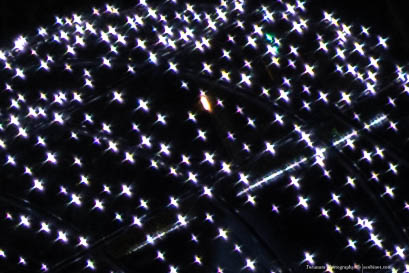
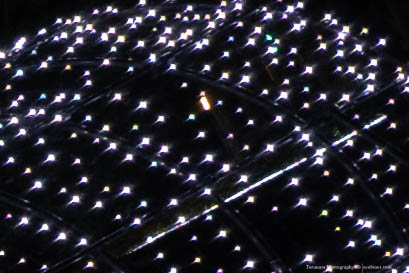
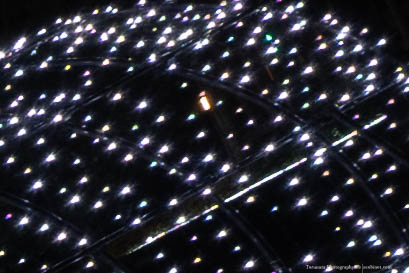
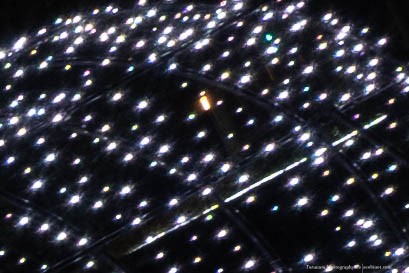
Spherical aberration
There is no extreme difference in the description before and after the focus, and spherical aberration seems to be well corrected.
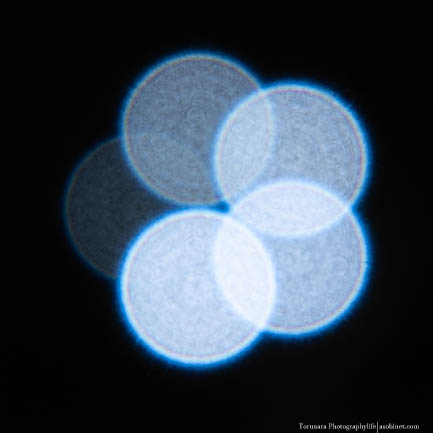
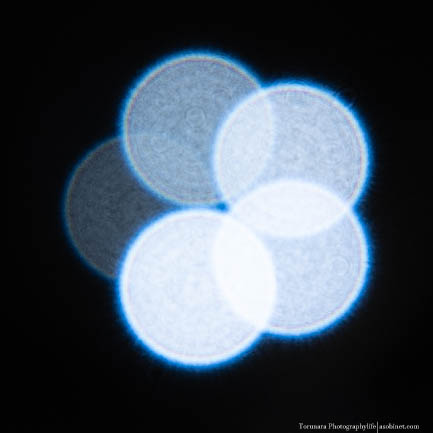
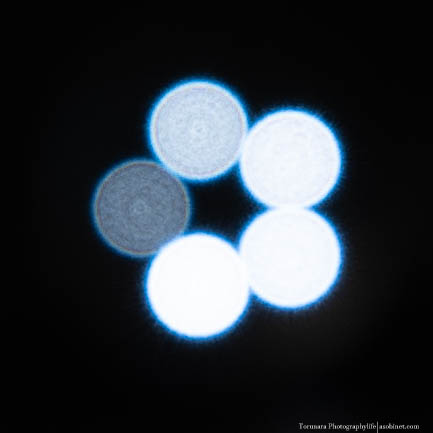
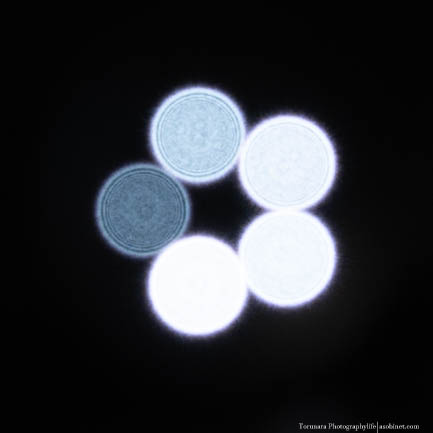
Foreground and background blur
What is a beautiful blur and a busy blur?
The evaluation of bokeh tends to be subjective, but I personally think that ‘soft, diffused bokeh’ is beautiful, while ‘sudden bokeh or hard-edged bokeh’ is not so good (or is a unique depiction). However, everyone has their own preferences, so there may be people who prefer the opposite. For reference, here are some examples of ‘blurred bokeh’ and ‘hard-edged bokeh’. The difference in the tendency of the depiction is mainly due to the state of correction of spherical aberration, and when the bokeh on either side is soft, there is a tendency for the bokeh on the other side to become hard.

Back Blur
While the foreground blur is smooth and beautiful, the background blur is harsh and gives a slightly noisy impression. Rather than neutral blur, there is a tendency to emphasize the background blur. Chromatic aberration is well corrected, so even the harsh foreground blur does not stand out.

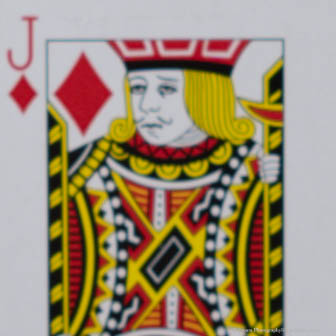
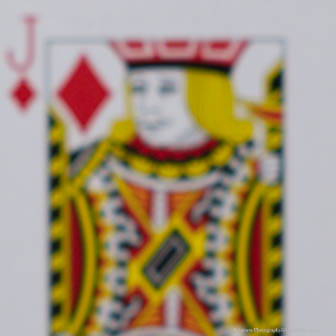
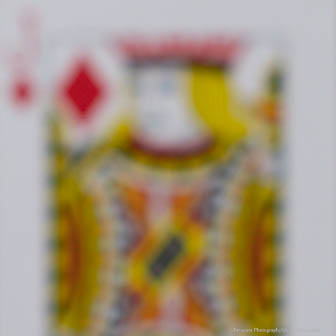
Front Blur

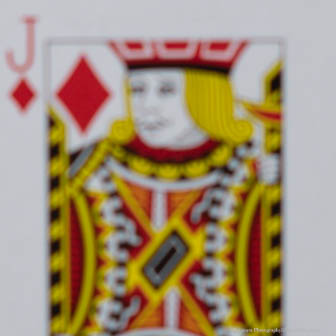
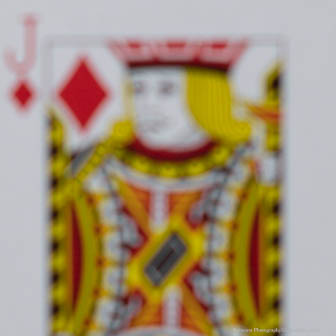
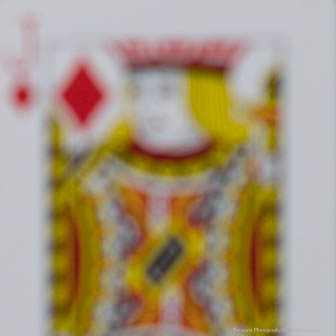
Bokehball
Effects of Vignetting and Spherical Aberration
If vignetting is strong, the bokeh at the four corners of the frame will be elliptically deformed or partially missing. The only way to solve this problem is to close down the aperture. However, closing down the aperture will make the bokeh smaller and in some cases the shape of the aperture blades may become visible, so it is necessary to compromise on the amount of vignetting depending on the situation.
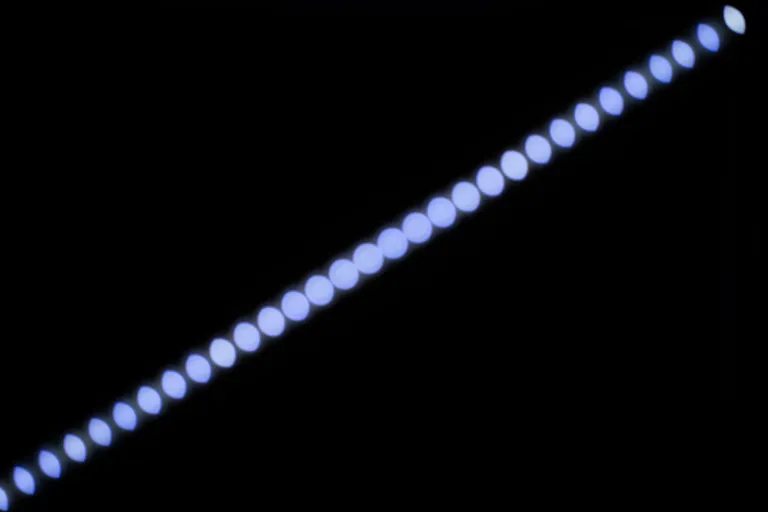
If the amount of vignetting is small, it is possible to get a circular bokeh from wide open to the four corners. Ideally, a lens with little vignetting is preferable, but to eliminate it, it is necessary to fundamentally increase the size of the lens. There is a need to strike a balance between portability and cost, so some kind of compromise is necessary.
If the correction of spherical aberration is not perfect, there will be a difference in the depiction of the bokeh in front and behind (as shown in the review of bokeh in front and behind). In this case, one side will have a smooth depiction with blurring, while the other side will have a hard depiction like double-line bokeh.
Test results
Although it is an ultra-wide-angle F4 lens, the minimum shooting distance is short, allowing for large bokeh. The bokeh is smooth and beautiful for a wide-angle lens. Despite using three aspherical lenses, there are no signs of onion bokeh. There is no vignetting, but the image appears to be stretched radially toward the corners. This gradually improves when the aperture is stopped down.

Sample of a boke
Close range
When shooting close-ups, there is a strong sense of depth, but you can achieve significant bokeh at F4. As a wide-angle lens, it produces smooth and beautiful images, with no particular points to note. There are no signs of onion bokeh. When you stop down, the bokeh edges become more pronounced, so if you prioritize bokeh quality, we recommend shooting at F4 with the aperture wide open.

Short range
As the shooting distance increases, the bokeh rapidly becomes smaller. Even so, the center and peripheral areas remain smooth and beautifully rendered. The bokeh quality changes to a noisy bokeh with astigmatism and coma aberration around the frame periphery, but this is not particularly noticeable when the subject is placed in the center. If you find the peripheral areas noisy, it is recommended to stop down by 1-2 stops.
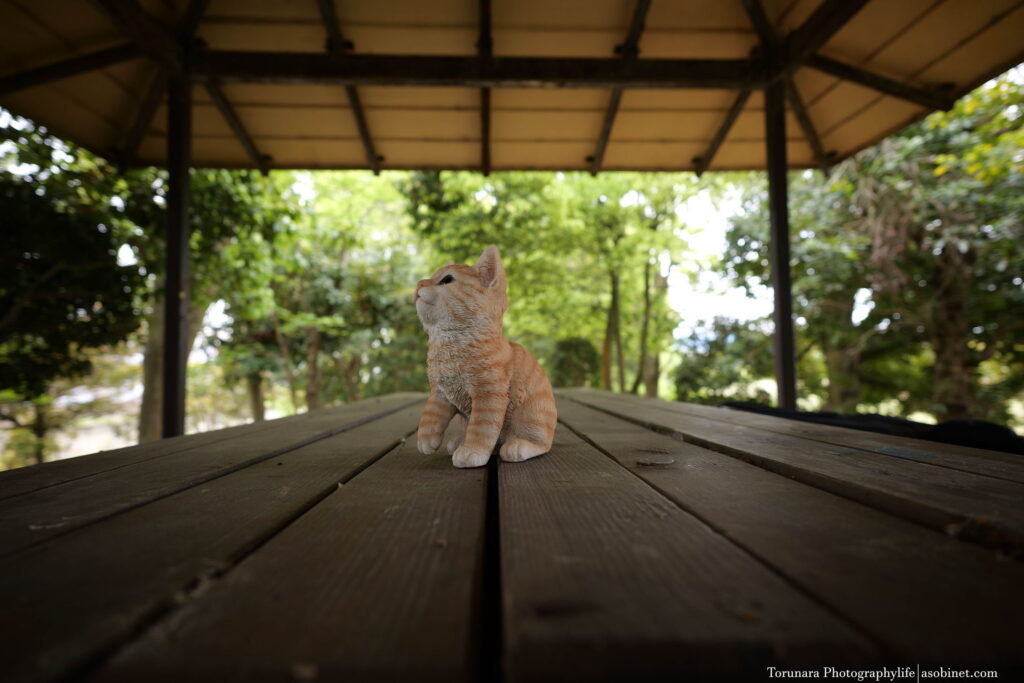
Medium range
As the shooting distance increases further, the bokeh becomes very small. Although it is not large enough to mention the bokeh quality, the center and its surroundings remain smooth. The edges and corners of the frame become rough, but this is not noticeable due to the small bokeh.
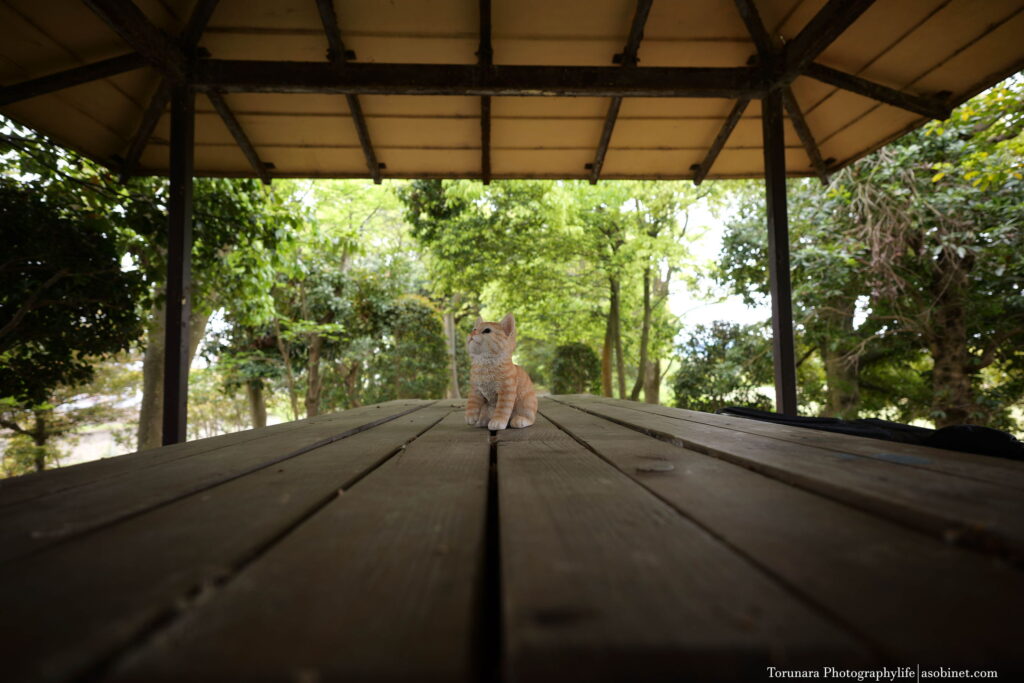
Portrait
The following are the results of taking pictures of a tripod that is 170cm tall while changing the distance and aperture.
When trying to fit the entire body into the frame, you will get almost no blur. By moving closer to the subject, up to about knee level or the upper body, the background will begin to blur slightly. The subject will separate from the background at about chest level or a close-up of the face. Due to the strong sense of distance in close-ups, you may find it difficult to shoot people with this lens while incorporating blur.
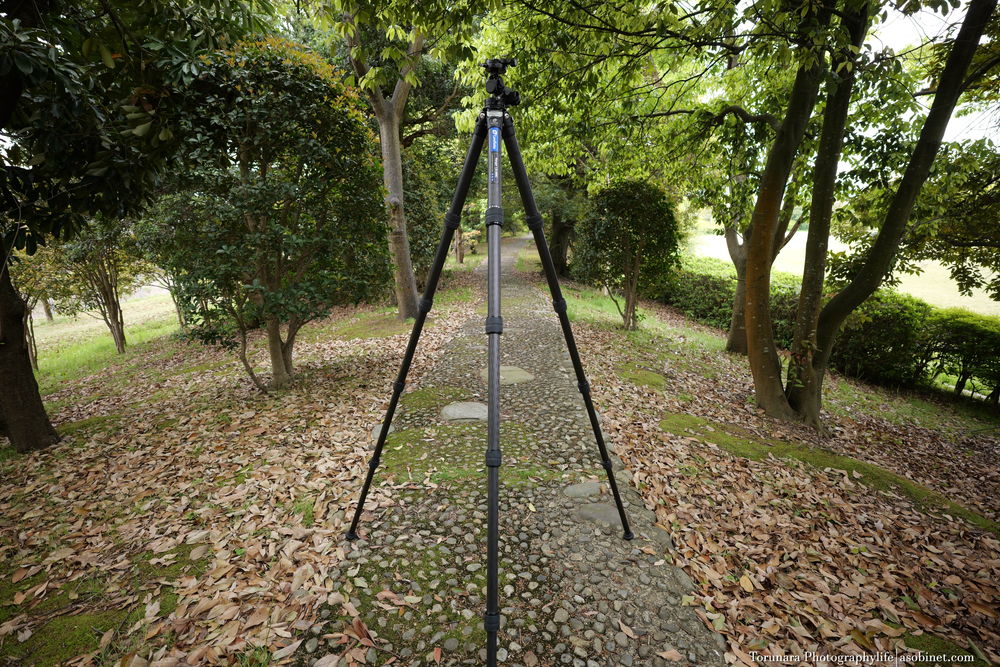
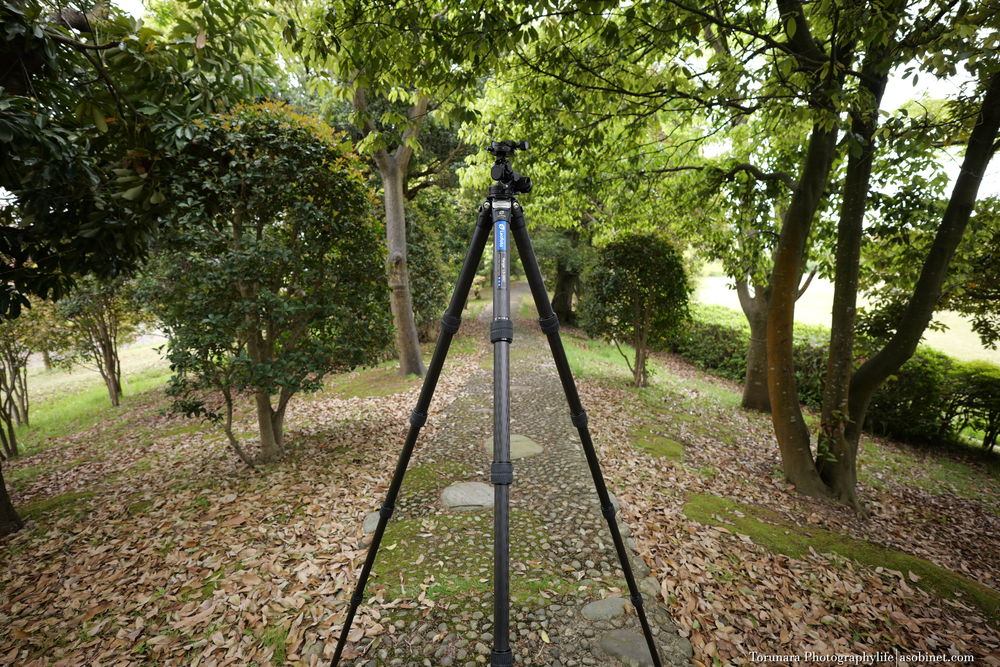
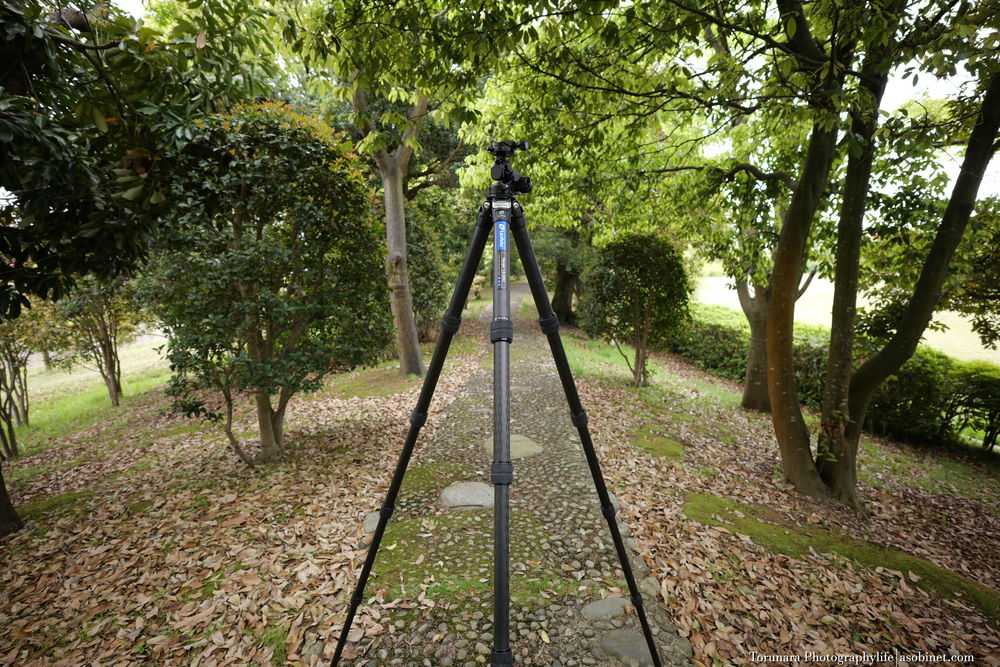
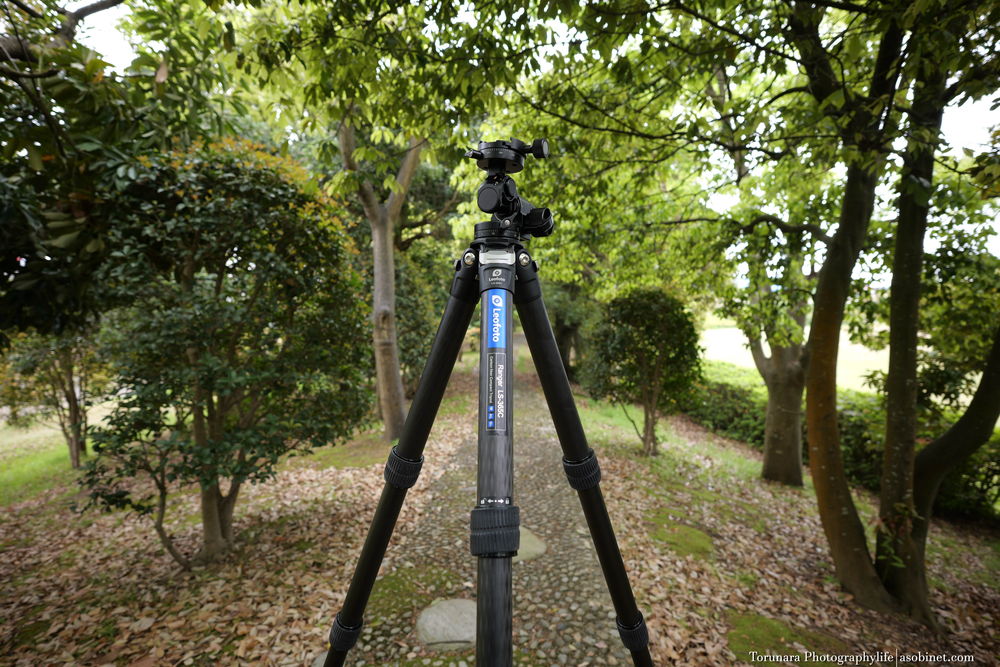
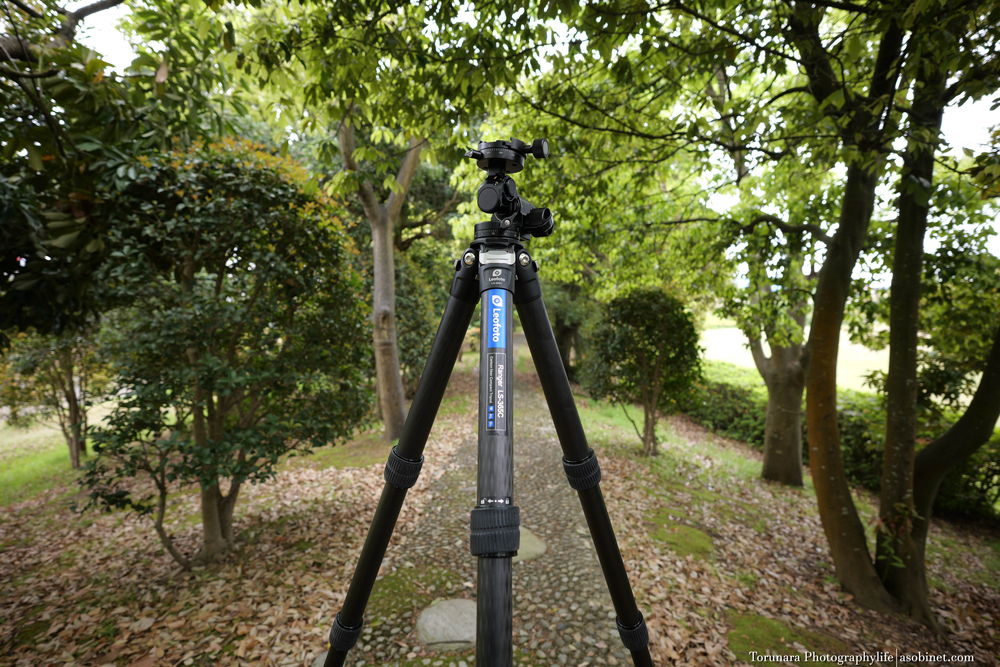
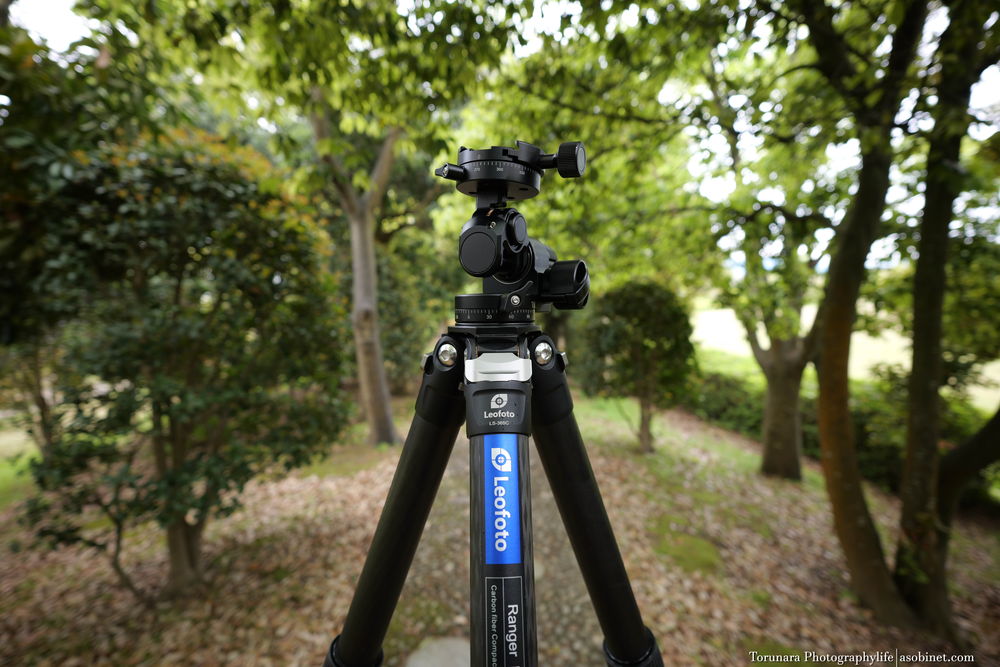
Vignetting
What is vignetting?
Unnatural drop in light intensity around the frame.
The light intensity is lower than in the central area, and there is insufficient exposure in the four corners of the frame. This mainly occurs with large-aperture lenses and wide-angle lenses.
Although this is a phenomenon that can be easily corrected using software, it is necessary to be careful about the fact that it can cause noise, as the insufficient exposure is covered by post-processing correction (sensitization). In particular, when using high sensitivity for nightscape or starry sky photography, there is a possibility that noise will appear strongly.


Minimum focusing distance
When the aperture is wide open, some peripheral light falloff is noticeable, but this improves when the aperture is narrowed. However, it cannot be completely suppressed. If you want to achieve a flat exposure, it seems that correction using a lens profile is essential.
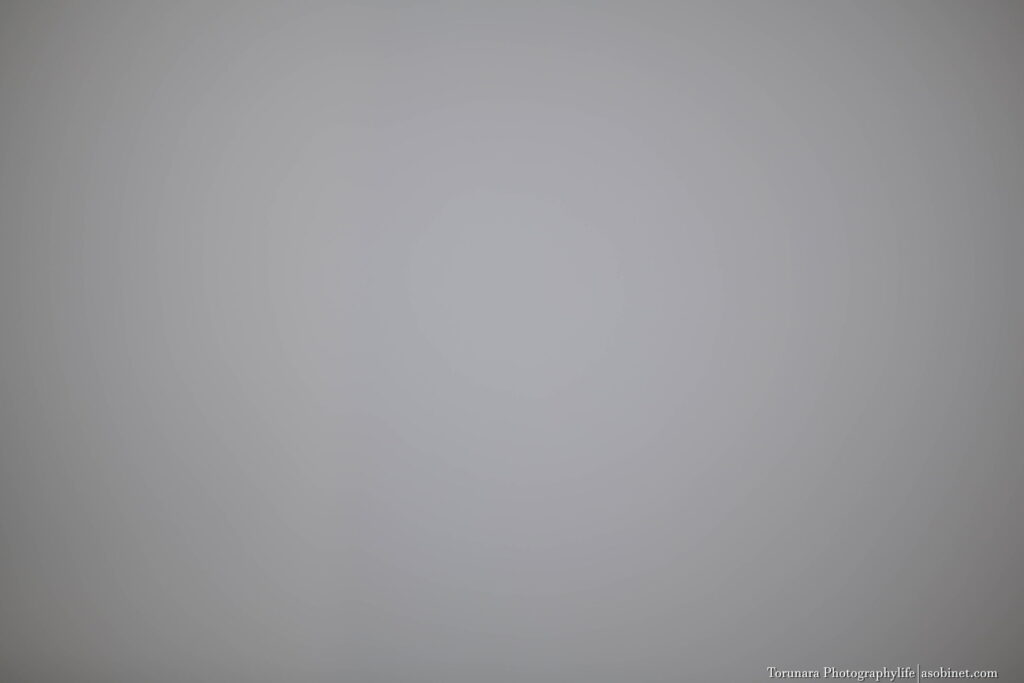
Infinity
Compared to the minimum shooting distance, there is even stronger light reduction. The effect of adjusting the aperture is minimal, and electronic correction is highly necessary. This is perhaps the biggest compromise of a compact, lightweight ultra-wide-angle lens.
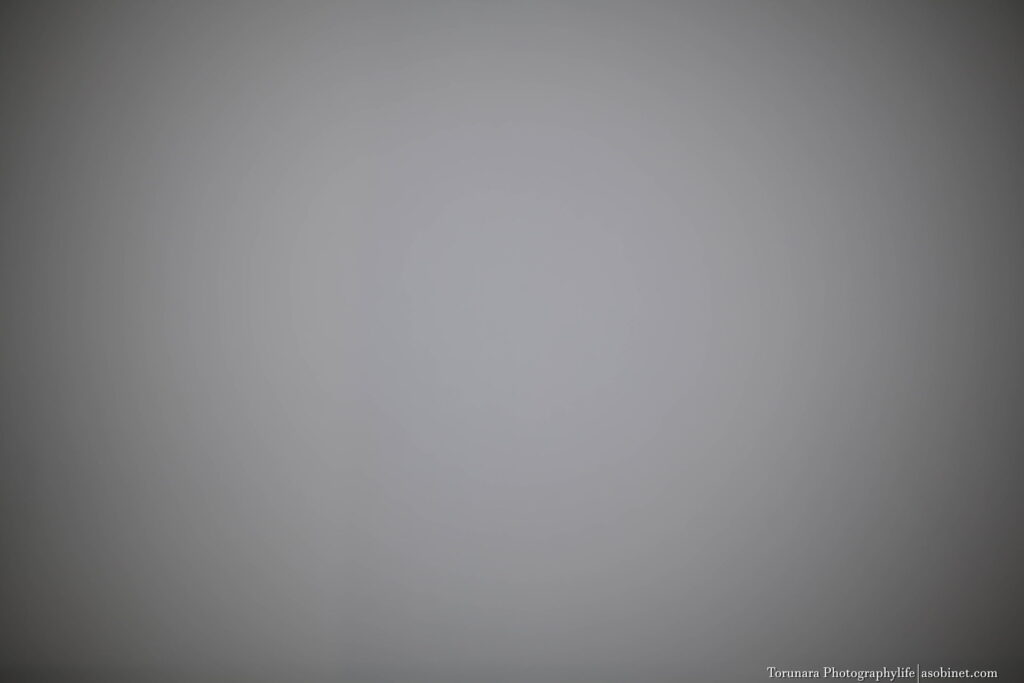
Backlight resistance, sunstar
centre
When a strong light source is placed in the center of the frame, flare and ghosting are well suppressed. Even when the aperture is narrowed, ghosting that was hidden does not become apparent, maintaining good performance.
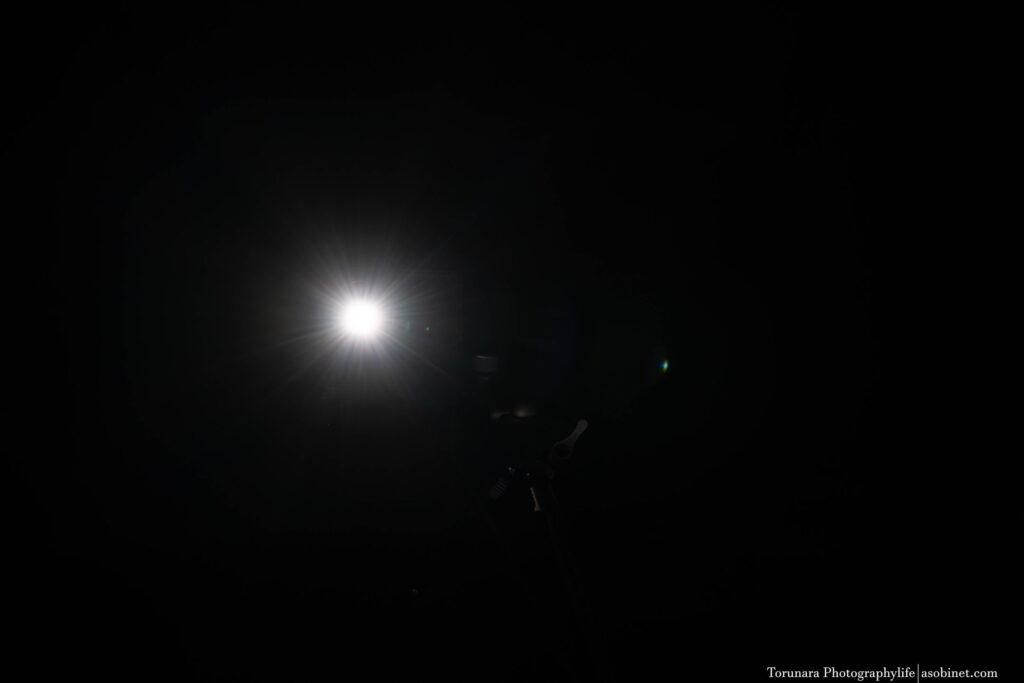
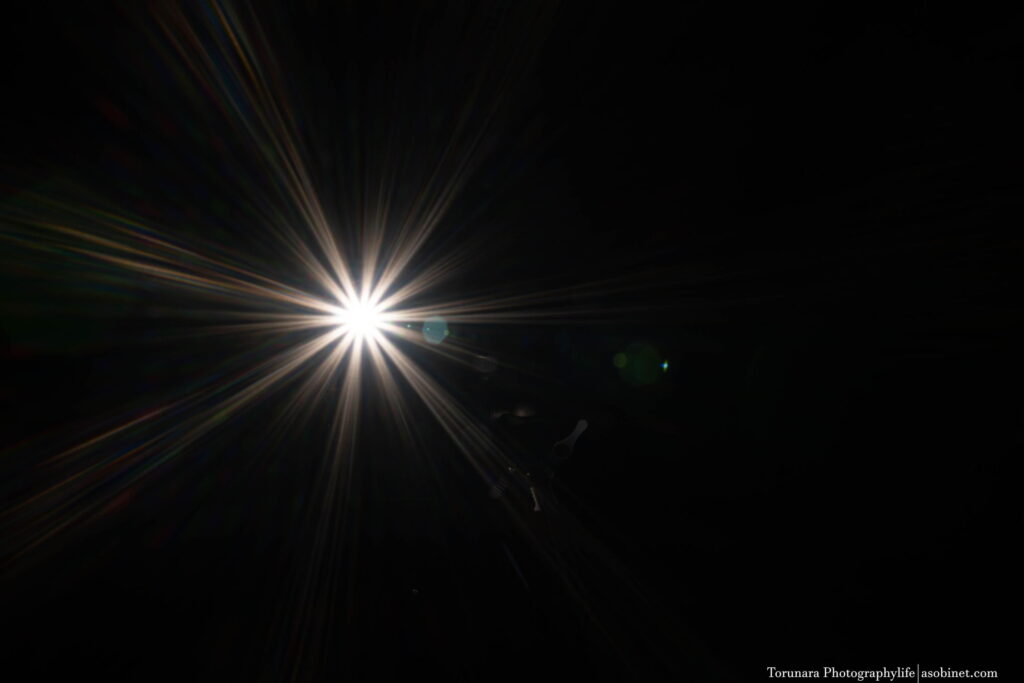
corner
Even when the light source is moved to the corner of the frame, the image remains clear. There is no significant change in backlight tolerance due to aperture.
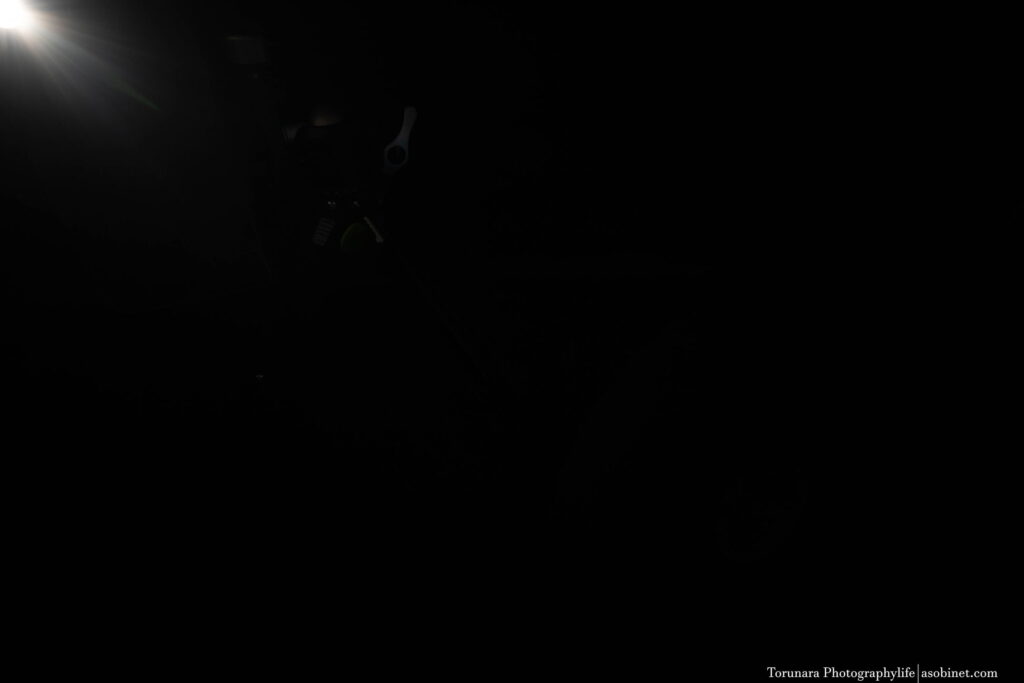
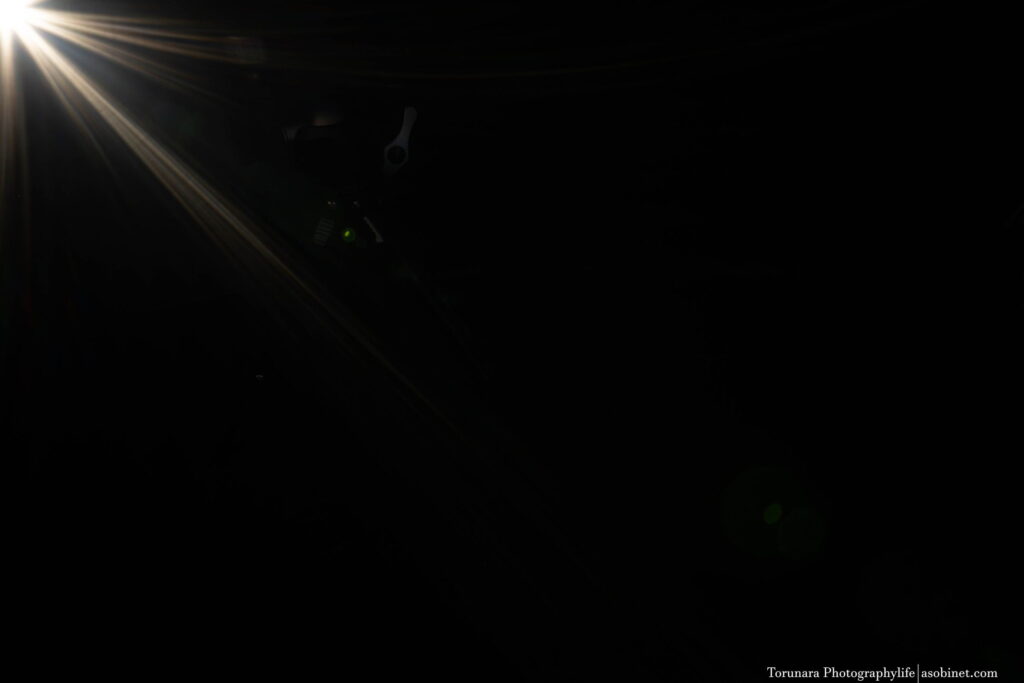
sunstar
It has excellent backlight resistance, but the light rays are not very good when the aperture is closed. There is no diffraction effect at apertures where diffraction occurs, and even when the aperture is closed, the light rays do not taper. If you want to close the aperture, it is better to use a cross filter.
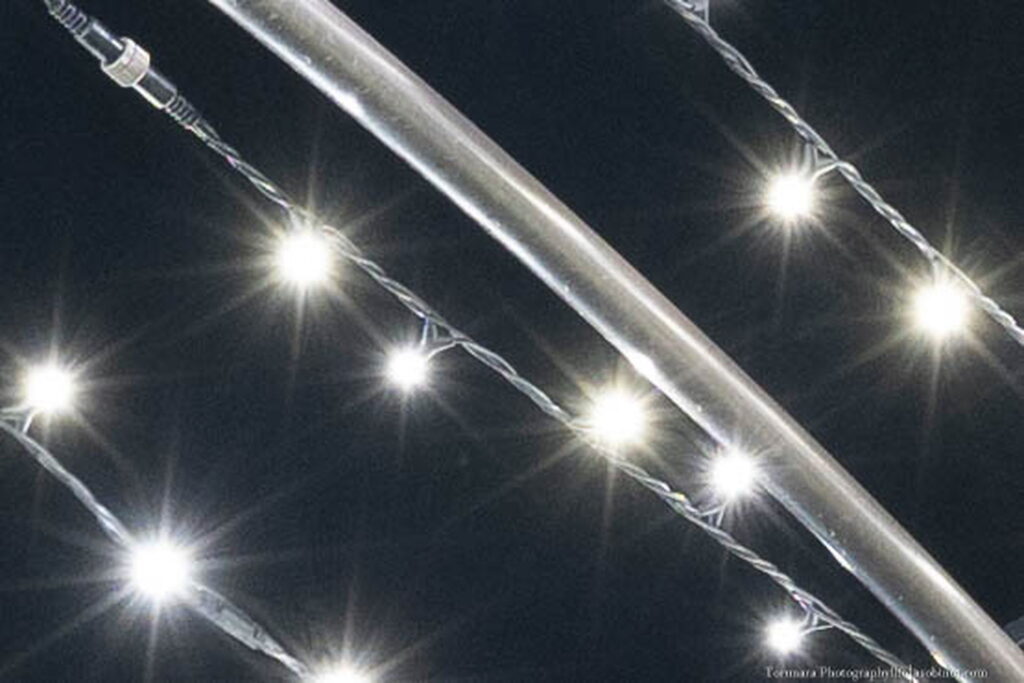
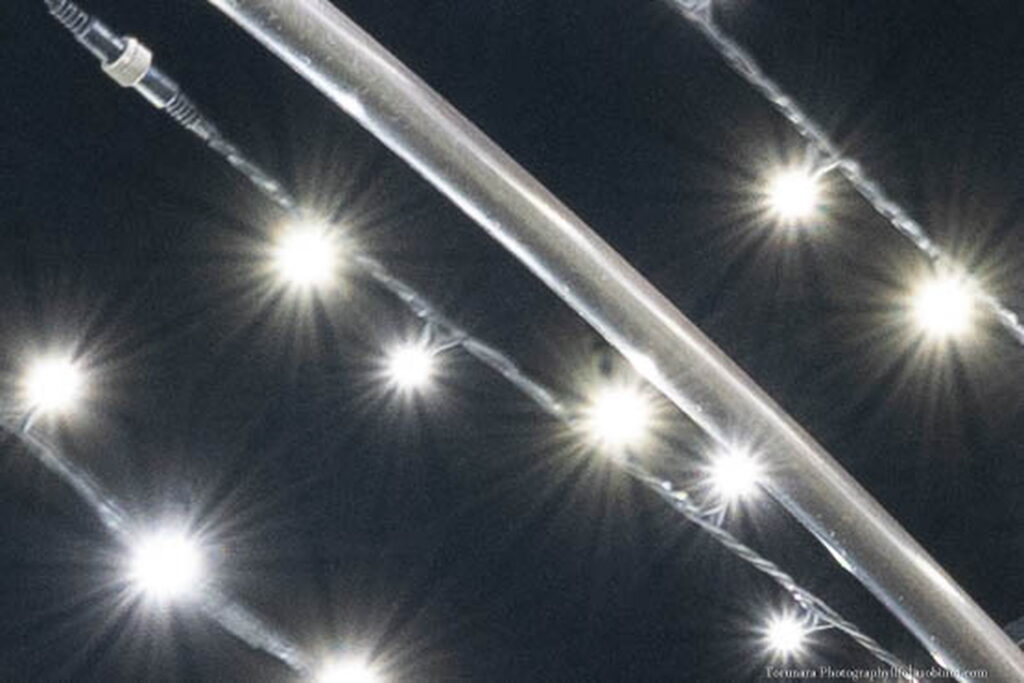
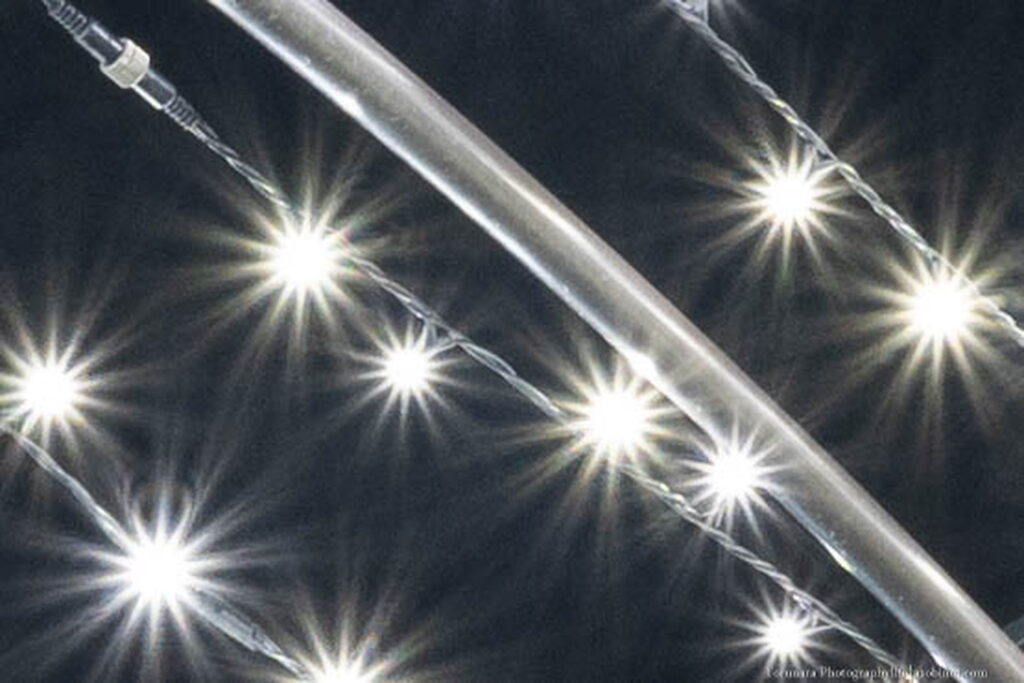
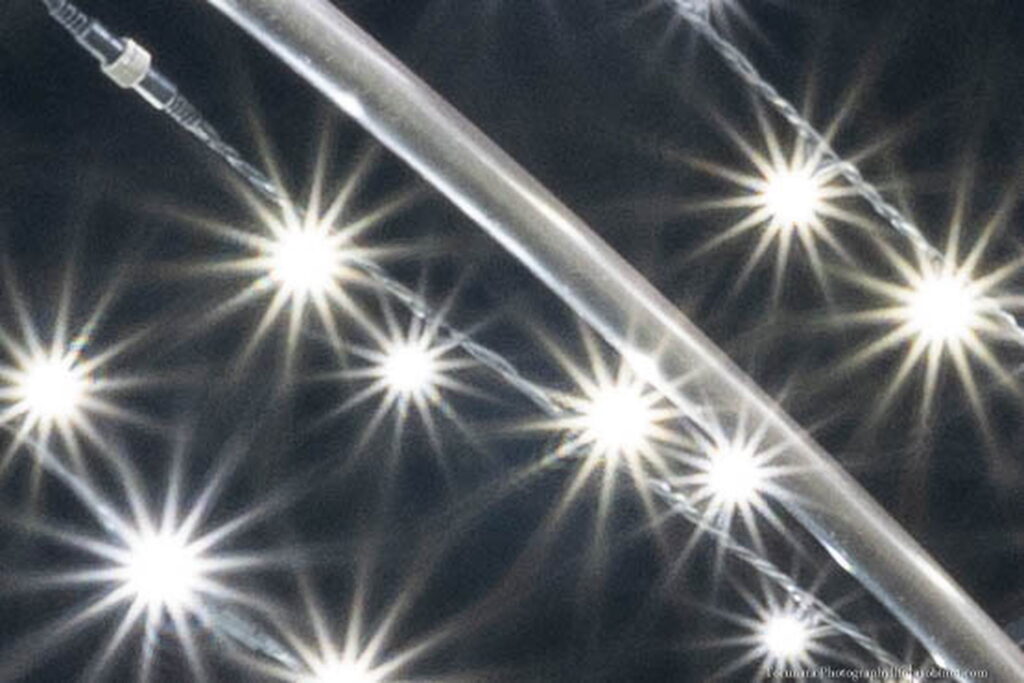
Summary

Good points

- High-quality metal barrel and lens hood
- Simple dust and splash resistance
- Easy-to-use focus ring
- Easy-to-use aperture ring
- Well-controlled focus breathing
- Consistent and uniform resolution performance across the entire focus range
- Good correction of magnification chromatic aberration
- Good correction of axial chromatic aberration
- Smooth background blur
- Excellent backlight resistance
This ultra-wide-angle lens is compact and lightweight, yet offers excellent optical performance and high build quality. Compared to other I Series lenses, it offers improved close-up performance, enabling a wide range of shooting applications, from close-ups of small subjects to distant scenes at infinity.
Bad points
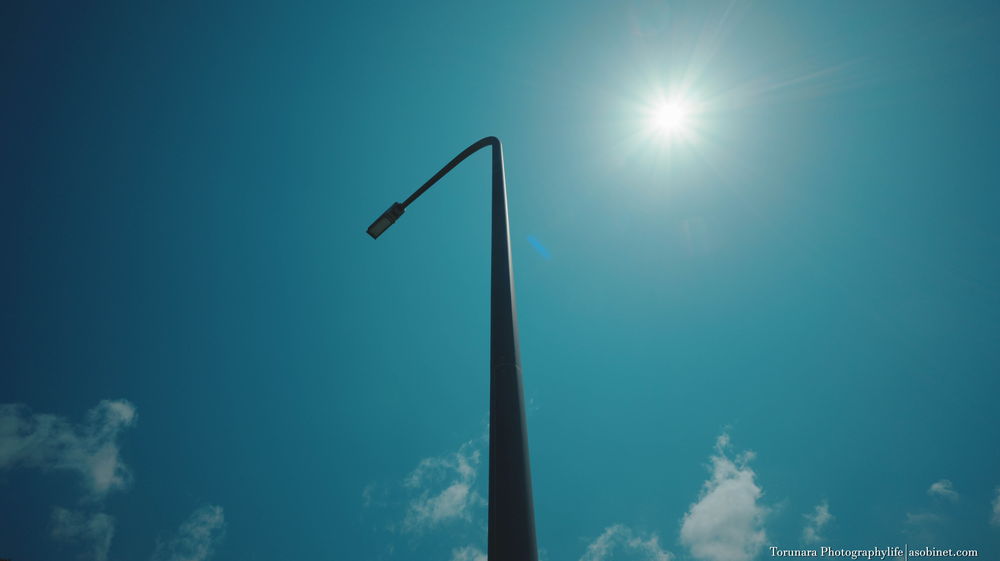
- Expensive
- The aperture ring does not support stepless operation
- Slow AF speed
- Noticeable distortion and significant cropping during correction
- Vignetting does not improve even when the aperture is closed
- Beautiful sunbursts do not appear even when the aperture is closed
Optical flaws are within the expected range for a compact, lightweight ultra-wide-angle lens. Distortion and peripheral light falloff require correction. The only real disappointment is that sharp light rays do not appear when the aperture is closed. Focus breathing is well controlled, making it suitable for video shooting, but it is unfortunate that the aperture ring does not allow for stepless operation. This lens is probably best suited for still photography.
Compared to its competitor, the Samyang “AF 18mm F2.8,” it is a more expensive option, but its build quality and optical performance are overwhelming. The price difference seems justified.
Conclusion

A compact, lightweight, high-performance 17mm ultra-wide-angle lens. While there are an increasing number of wide-angle lenses available for mirrorless cameras, this one stands out for its build quality and optical performance. Although the price is on the higher side, it is one of the lenses I would strongly recommend.
The only competing product for the Sony E-mount is the Samyang “AF 18mm F2.8.” It is affordable, compact, and lightweight, and has a wider aperture than the Sigma. It is an attractive option with good value for the price, but it is important to note that the build quality is clearly inferior to the Sigma (there are many plastic parts and the overall feel is not very good).
Lens Buying Guide
Creating in-depth reviews like this requires time and resources.If you found this article useful and decided to buy a lens, please consider using the affiliate link. This will help us to create more content in the future.
Example
The original data is available on Flickr.
